Paul van Yperen's Blog, page 127
April 22, 2022
La Collectionneuse: Carmen
'Carmen', a novella written by French writer Prosper Mérimée, was first published in 1845. It tells the story of Don José, a dragoon officer in Sevilla, who lets escape a fiery gypsy called Carmen, who had been arrested after a violent brawl with one of her tobacco factory’s colleagues. As a result, he is imprisoned and demoted. After his release, he falls madly in love with her and he ends up joining her outlaw band. All ends in tragedy as José, mad with jealousy, kills the hot-blooded and elusive Carmen.
The opera 'Carmen' was based on Mérimée’s novella and was first performed in 1875. However, the author, Georges Bizet, who died the same year, never knew that his work would become such a classic, as it took several years for Carmen to be a hit. Its success has never waivered ever since and it has become one of the best-known and most popular operas of all time, with evergreens such as the habanera 'L’amour est un oiseau rebelle' and the 'Toreador’s Song'. The passionate and tragic love affair between Carmen and José has been kept by Bizet as the centre of the story. But the character of Escamillo, a famous torero infatuated with Carmen, is also given much prominence.
There have been many film versions of Carmen from about 1906 to the present day, based either on Mérimée’s novella or on Bizet’s opera, or a combination of both. Here is a selection of nine film Carmens.
Theda Bara

American postcard by Kline Poster Co. Inc., Philadelphia. Photo: Fox. Theda Bara in Carmen (Raoul Walsh, 1915).
Carmen (1915), directed by Raoul Walsh, was one of the prestige movies produced by Fox for their reigning vamp, Theda Bara. The company was said to have spent an estimated $30,000 recreating Sevilla in their Fort Lee studios. A concurrent version, starring opera diva Geraldine Farrar and directed by Cecil B. De Mille , was released simultaneously. Although the critics generally preferred De Mille’s movie, Theda Bara’s Carmen was a hit at the box office.
Pola Negri
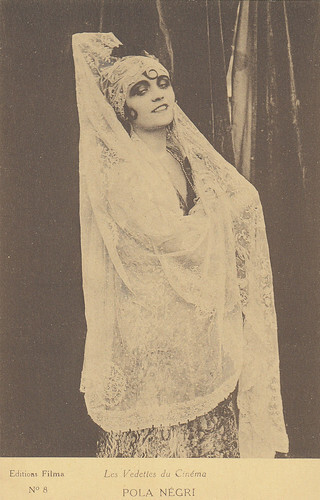
French postcard by Editions Filma in the Les Vedettes du Cinéma series, no. 8. Pola Negri in Carmen (Ernst Lubitsch, 1918).
Carmen (1918) was the second of the seven films Pola Negri made with Ernst Lubitsch. Their association was one of the most successful ones in silent movie history. Negri’s frequent co-star Harry Liedtke played Don José. In 1921, Carmen was released in the U.S.A. under the title Gypsy Blood. It was warmly welcomed by audiences and critics alike and was one of Negri’s German movies which paved her way to Hollywood stardom.
Raquel Meller

Italian postcard by G. Vettori Bologna, no. 3544. Raquel Meller and Raymond Guérin-Catelain in Carmen (Jacques Feyder, 1926).
French movie Carmen (1926) was conceived as a star vehicle for famous Spanish singer Raquel Meller . Reportedly, Meller and director Jacques Feyder didn’t get along well during filming. The actress wanted to make Carmen appear more as a victim than a femme fatale, while Feyder preferred her to play the character as Merimée had conceived it. Later Feyder declared that he had been asked "not to do a film of 'Carmen' with Raquel Meller but to do something with Raquel Meller on Carmen". Nevertheless, the film pleased the audiences and was praised for its authentic feel.
Dolores Del Rio
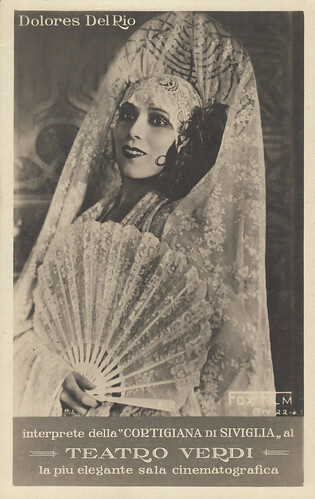
Italian postcard by G. Vettori Bologna. Photo: Fox-Film. Dolores Del Rio in The Loves of Carmen (Raoul Walsh, 1927).
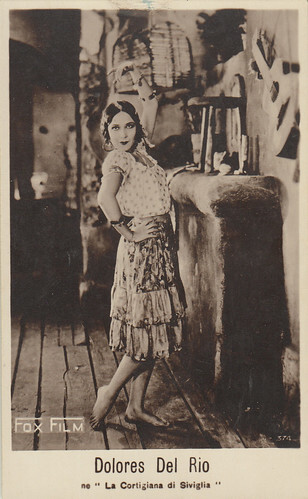
Italian postcard by G.B. Falci Editore, Milano, no. 374. Photo: Fox Film. Dolores Del Rio in The Loves of Carmen (Raoul Walsh, 1927).
Twelve years after having directed Theda Bara in Carmen, Raoul Walsh gave audiences another lavish version of Merimée’s novel with The Loves of Carmen (1927), starring Mexican-born Dolores Del Rio . Don Alvarado played Don José and Victor McLaglen was torero Escamillo. According to a review by famous critic Mordaunt Hall published in the New York Times in September 1927, "Miss Del Rio, with her bright eyes, pretty lips and lithe figure, gives a decidedly unrestrained portrait of the faithless creature and her characterization is apt to make the Carmens of the past appear relatively conservative".
Imperio Argentina
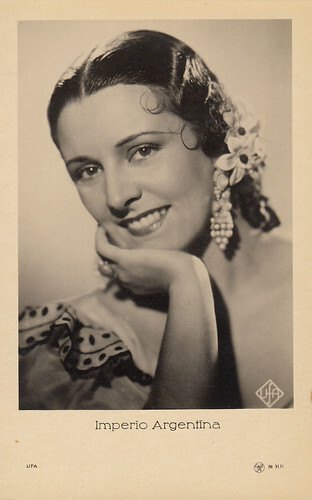
Latvian postcard by EMBR, no. 3131. Photo: Ufa. Imperio Argentina in Carmen (la de Triana)/Andalusisches Nächte (Florián Rey, 1938).
Carmen (la de Triana)/Andalusisches Nächte (1938) was a Spanish-German co-production filmed in two versions, both starring popular actress and singer Imperio Argentina . Important changes were made to the plot as Carmen is not killed at the end of the story and Don José dies a hero by saving his former comrades in arms, ambushed by smugglers. In the German-language version, Friedrich Benfer was substitued to Rafael Rivelles as Don José.
Viviane Romance
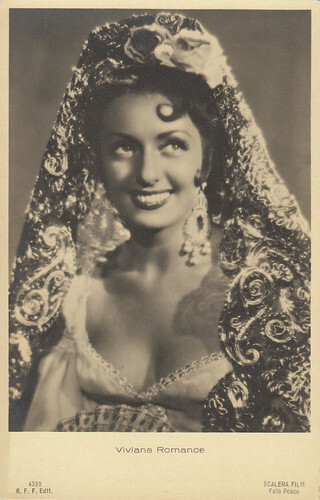
Italian postcard by Ballerini & Fratini, Firenze, no. 4392. Photo: Scalera Film / Pesce. Viviane Romance in Carmen (Christian-Jaque, 1944).
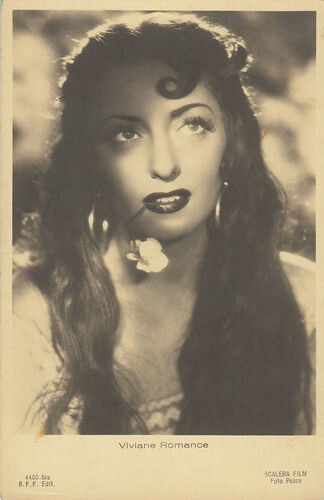
Italian postcard by Ballerini & Fratini, Firenze, no. 4400.bis. Photo: Scalera Film / Pesce. Viviane Romance in Carmen (Christian-Jaque, 1944).
Carmen (1944) was a French-Italian co-production and was filmed in the Scalera Studios in Rome. French star Viviane Romance ’s sultry brunette looks and fiery temperament were well-suited for the Carmen character. Jean Marais , who had just shot to stardom with L’éternel retour one year before, played Don José.
Rita Hayworth
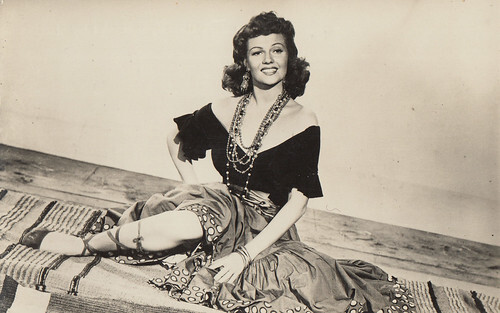
Spanish postcard, no. 2427. Rita Hayworth in The Loves of Carmen (Charles Vidor, 1948).
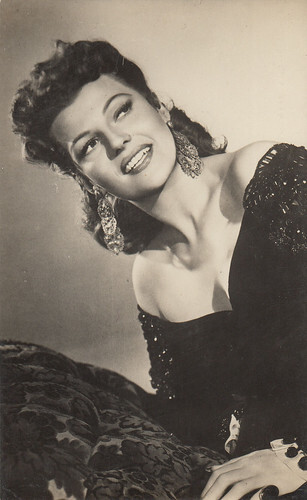
Spanish postcard, no. 2453. Rita Hayworth in The Loves of Carmen (Charles Vidor, 1948).
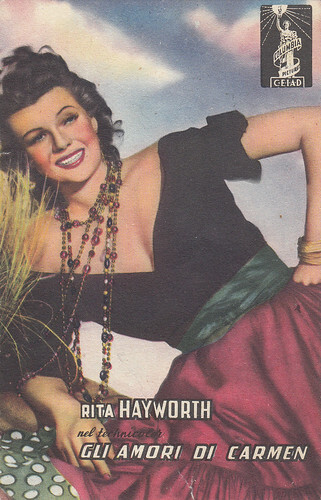
Italian promotional postcard. Rita Hayworth in The Loves of Carmen (Charles Vidor, 1948).
The Loves of Carmen (1948) was produced by Columbia to showcase their number one female star at the time, Rita Hayworth . Glenn Ford, her Gilda co-star, played Don José. As Hayworth was co-producer of the movie, she hired her father, Spanish-born Eduardo Cansino, to choreograph the dances. The Loves of Carmen was a crowd-pleaser. Rita Hayworth fans were thrilled to see their idol back to her usual self after having been transformed into an icy short-haired blonde by Orson Welles in The Lady from Shanghai one year before.
Dorothy Dandridge
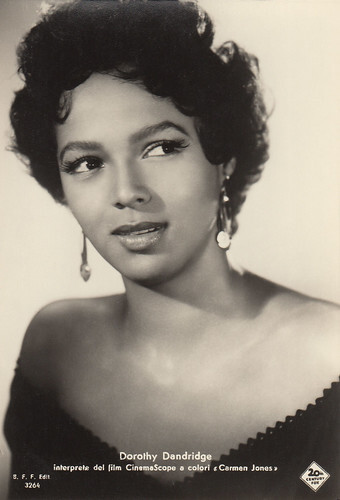
Italian postcard by B.F.F. Edit., no. 3264. Photo: 20th Century Fox. Dorothy Dandridge in Carmen Jones (Otto Preminger, 1954).
Carmen Jones (1954) was based on the successful Oscar Hammerstein II’s Broadway musical which ran from the 2nd of December 1943 to the 10th of February 1945. It was adapted from Bizet’s opera but the action took place in the Afro-American community during World War II. Bizet’s music was used but with new lyrics. In the plot, Carmen became a parachute factory worker, Don José became Corporal Joe and torero Escamillo became Husky Miller, a boxing champion. At first, director and producer Otto Preminger didn’t want to cast Dorothy Dandridge as Carmen, as he thought she was too sophisticated for the role. It was only when the actress turned up at an appointment swinging her hips in a sexy outfit that he knew he had found his right Carmen. Dandridge and Preminger soon began a love affair that lasted a few years but which was over at the time he directed her again in Porgy and Bess (1959). As Preminger was convinced that only opera-trained voices could do justice to Bizet’s music, he hired Marilyn Horne and Le Vern Hutchinson to dub Dandridge and Harry Belafonte , who played Joe, for their songs. Carmen Jones made Dorothy Dandridge a star and earned her a Best Actress Oscar nomination, which was a first for an Afro-American woman.
Sara Montiel
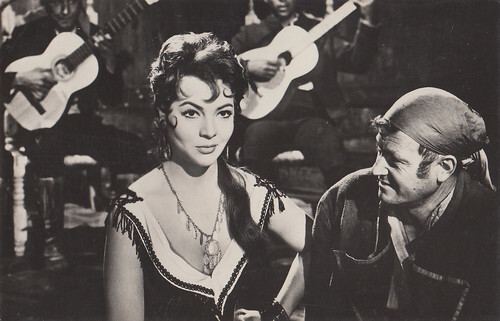
Spanish postcard, no. 3136. Sara Montiel in Carmen la de Ronda/The Devil Made a Woman (Tulio Demicheli, 1959).
In Carmen la de Ronda (1959), Spanish superstar Sara Montiel played Carmen opposite French actor Maurice Ronet as Don José. The Carmen character was transformed from a tobacco factory worker to a café singer. This allowed Sara Montiel to perform several songs to please her eager fans.
Text and postcards: Marlene Pilaete.
The opera 'Carmen' was based on Mérimée’s novella and was first performed in 1875. However, the author, Georges Bizet, who died the same year, never knew that his work would become such a classic, as it took several years for Carmen to be a hit. Its success has never waivered ever since and it has become one of the best-known and most popular operas of all time, with evergreens such as the habanera 'L’amour est un oiseau rebelle' and the 'Toreador’s Song'. The passionate and tragic love affair between Carmen and José has been kept by Bizet as the centre of the story. But the character of Escamillo, a famous torero infatuated with Carmen, is also given much prominence.
There have been many film versions of Carmen from about 1906 to the present day, based either on Mérimée’s novella or on Bizet’s opera, or a combination of both. Here is a selection of nine film Carmens.
Theda Bara

American postcard by Kline Poster Co. Inc., Philadelphia. Photo: Fox. Theda Bara in Carmen (Raoul Walsh, 1915).
Carmen (1915), directed by Raoul Walsh, was one of the prestige movies produced by Fox for their reigning vamp, Theda Bara. The company was said to have spent an estimated $30,000 recreating Sevilla in their Fort Lee studios. A concurrent version, starring opera diva Geraldine Farrar and directed by Cecil B. De Mille , was released simultaneously. Although the critics generally preferred De Mille’s movie, Theda Bara’s Carmen was a hit at the box office.
Pola Negri

French postcard by Editions Filma in the Les Vedettes du Cinéma series, no. 8. Pola Negri in Carmen (Ernst Lubitsch, 1918).
Carmen (1918) was the second of the seven films Pola Negri made with Ernst Lubitsch. Their association was one of the most successful ones in silent movie history. Negri’s frequent co-star Harry Liedtke played Don José. In 1921, Carmen was released in the U.S.A. under the title Gypsy Blood. It was warmly welcomed by audiences and critics alike and was one of Negri’s German movies which paved her way to Hollywood stardom.
Raquel Meller

Italian postcard by G. Vettori Bologna, no. 3544. Raquel Meller and Raymond Guérin-Catelain in Carmen (Jacques Feyder, 1926).
French movie Carmen (1926) was conceived as a star vehicle for famous Spanish singer Raquel Meller . Reportedly, Meller and director Jacques Feyder didn’t get along well during filming. The actress wanted to make Carmen appear more as a victim than a femme fatale, while Feyder preferred her to play the character as Merimée had conceived it. Later Feyder declared that he had been asked "not to do a film of 'Carmen' with Raquel Meller but to do something with Raquel Meller on Carmen". Nevertheless, the film pleased the audiences and was praised for its authentic feel.
Dolores Del Rio

Italian postcard by G. Vettori Bologna. Photo: Fox-Film. Dolores Del Rio in The Loves of Carmen (Raoul Walsh, 1927).

Italian postcard by G.B. Falci Editore, Milano, no. 374. Photo: Fox Film. Dolores Del Rio in The Loves of Carmen (Raoul Walsh, 1927).
Twelve years after having directed Theda Bara in Carmen, Raoul Walsh gave audiences another lavish version of Merimée’s novel with The Loves of Carmen (1927), starring Mexican-born Dolores Del Rio . Don Alvarado played Don José and Victor McLaglen was torero Escamillo. According to a review by famous critic Mordaunt Hall published in the New York Times in September 1927, "Miss Del Rio, with her bright eyes, pretty lips and lithe figure, gives a decidedly unrestrained portrait of the faithless creature and her characterization is apt to make the Carmens of the past appear relatively conservative".
Imperio Argentina

Latvian postcard by EMBR, no. 3131. Photo: Ufa. Imperio Argentina in Carmen (la de Triana)/Andalusisches Nächte (Florián Rey, 1938).
Carmen (la de Triana)/Andalusisches Nächte (1938) was a Spanish-German co-production filmed in two versions, both starring popular actress and singer Imperio Argentina . Important changes were made to the plot as Carmen is not killed at the end of the story and Don José dies a hero by saving his former comrades in arms, ambushed by smugglers. In the German-language version, Friedrich Benfer was substitued to Rafael Rivelles as Don José.
Viviane Romance

Italian postcard by Ballerini & Fratini, Firenze, no. 4392. Photo: Scalera Film / Pesce. Viviane Romance in Carmen (Christian-Jaque, 1944).

Italian postcard by Ballerini & Fratini, Firenze, no. 4400.bis. Photo: Scalera Film / Pesce. Viviane Romance in Carmen (Christian-Jaque, 1944).
Carmen (1944) was a French-Italian co-production and was filmed in the Scalera Studios in Rome. French star Viviane Romance ’s sultry brunette looks and fiery temperament were well-suited for the Carmen character. Jean Marais , who had just shot to stardom with L’éternel retour one year before, played Don José.
Rita Hayworth

Spanish postcard, no. 2427. Rita Hayworth in The Loves of Carmen (Charles Vidor, 1948).

Spanish postcard, no. 2453. Rita Hayworth in The Loves of Carmen (Charles Vidor, 1948).

Italian promotional postcard. Rita Hayworth in The Loves of Carmen (Charles Vidor, 1948).
The Loves of Carmen (1948) was produced by Columbia to showcase their number one female star at the time, Rita Hayworth . Glenn Ford, her Gilda co-star, played Don José. As Hayworth was co-producer of the movie, she hired her father, Spanish-born Eduardo Cansino, to choreograph the dances. The Loves of Carmen was a crowd-pleaser. Rita Hayworth fans were thrilled to see their idol back to her usual self after having been transformed into an icy short-haired blonde by Orson Welles in The Lady from Shanghai one year before.
Dorothy Dandridge

Italian postcard by B.F.F. Edit., no. 3264. Photo: 20th Century Fox. Dorothy Dandridge in Carmen Jones (Otto Preminger, 1954).
Carmen Jones (1954) was based on the successful Oscar Hammerstein II’s Broadway musical which ran from the 2nd of December 1943 to the 10th of February 1945. It was adapted from Bizet’s opera but the action took place in the Afro-American community during World War II. Bizet’s music was used but with new lyrics. In the plot, Carmen became a parachute factory worker, Don José became Corporal Joe and torero Escamillo became Husky Miller, a boxing champion. At first, director and producer Otto Preminger didn’t want to cast Dorothy Dandridge as Carmen, as he thought she was too sophisticated for the role. It was only when the actress turned up at an appointment swinging her hips in a sexy outfit that he knew he had found his right Carmen. Dandridge and Preminger soon began a love affair that lasted a few years but which was over at the time he directed her again in Porgy and Bess (1959). As Preminger was convinced that only opera-trained voices could do justice to Bizet’s music, he hired Marilyn Horne and Le Vern Hutchinson to dub Dandridge and Harry Belafonte , who played Joe, for their songs. Carmen Jones made Dorothy Dandridge a star and earned her a Best Actress Oscar nomination, which was a first for an Afro-American woman.
Sara Montiel

Spanish postcard, no. 3136. Sara Montiel in Carmen la de Ronda/The Devil Made a Woman (Tulio Demicheli, 1959).
In Carmen la de Ronda (1959), Spanish superstar Sara Montiel played Carmen opposite French actor Maurice Ronet as Don José. The Carmen character was transformed from a tobacco factory worker to a café singer. This allowed Sara Montiel to perform several songs to please her eager fans.
Text and postcards: Marlene Pilaete.
Published on April 22, 2022 22:00
April 21, 2022
Dean Martin
American actor, singer, and comedian Dean Martin (1917-1995) was one of the most popular and enduring American entertainers of the mid-20th century. The charismatic and self-assured Martin was nicknamed 'The King of Cool'.
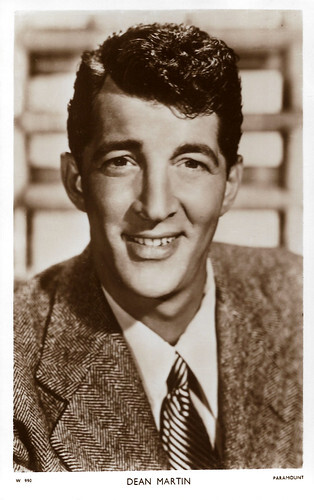
British postcard in the Picturegoer Series, no. W 990. Photo: Paramount.
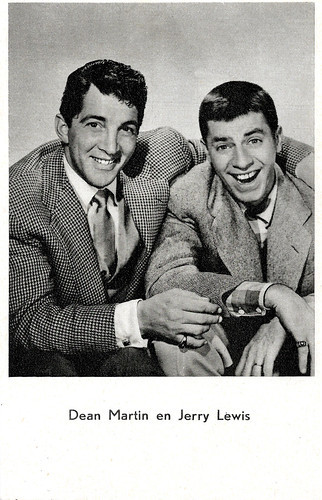
Dutch card. Dean Martin and Jerry Lewis .
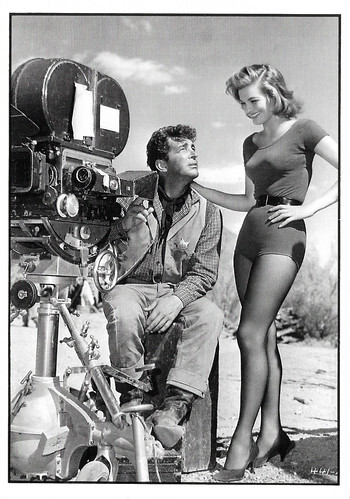
French postcard in the Entr'acte series by Éditions Asphodèle. Mâcon, no. 006/7. Collection: B. Courtel / D.R. Dean Martin and Angie Dickinson in 1958 at the set of Rio Bravo (Howard Hawks, 1959). Caption: Dean Martin and his partner Angie Dickinson behind the camera for a break.
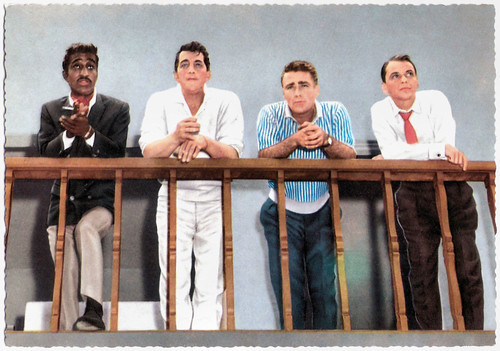
German postcard by Krüger, no. 902/193. Photo: Terb Agency. Sammy Davis Jr., Dean Martin, Peter Lawford, and Frank Sinatra .
A duo with Jerry Lewis
Dean Martin was born Dino Paul Crocetti in Steubenville, Ohio, in 1917. His parents were Gaetano Alfonso "Guy" Crocetti, an Italian immigrant and barber, and his Ohio-born wife, Angela (Barra) Crocetti. He spoke only Italian until age five. Martin came up the hard way, with such jobs as a boxer ("Kid Crochet"), a steel mill worker, a gas station worker, and a casino croupier/dealer.
He managed to establish himself as a singer in New York clubs under the stage name "Dean Martin". In order to have more chances to establish his career, Dino Paul Crocetti legally changed his name to a more American one and chose the surname "Martin" because it was an English version of the surname of the Italian tenor Nino Martini.
In 1946, he got his first ticket to stardom, as he teamed up with another hard worker who was also trying to succeed in Hollywood: Jerry Lewis . They first met at the Glass Hat Club in New York, where they both performed. The two artists formed a successful comedy duo, which lasted for about ten years. His first collaboration with Jerry Lewis was on 25 July 1946 at Club 500 in Atlantic City, and together they developed a successful comedy routine. They divided their show between songs, skits, with Lewis playing the "naughty boy" of comedy, i.e. improvised comedy.
The duo eventually found success and began a series of successful performances across the country, culminating in a show at New York's Copacabana nightclub. The act featured Lewis interrupting and annoying Martin as he tried to sing, with the two eventually chasing each other around the stage. The secret of the show's success, they both said, was that they ignored the audience and only tried to interact with each other, to make it as spontaneous as possible.
In 1949, the pair made their first film My Friend Irma (George Marshall, 1949) featuring Marie Wilson. Their joint television debut was in The Colgate Comedy Hour (1950), a variety show that they would also present occasionally between 1950 and 1955. They also had their own radio show. In 1951 they starred in the film hit At War with the Army (Hal Walker, 1950), which sent the team toward super-stardom. The thirteen films they made after that were based on the formula of this film.
The duo was to become one of Hollywood's truly great teams. Their agent, Abby Greshler, negotiated for them one of the best business deals in Hollywood history: despite receiving only $75,000 together from the profits of their films, Martin and Lewis were free to make one film a year as independents, which they would co-produce through York Productions, which they owned. They lasted 11 years together and starred in sixteen films, from My Friend Irma (George Marshall, 1949) to Hollywood or Bust (Frank Tashlin, 1956).
However, due to growing personal differences, the artistic partnership, and thus the collaboration with Lewis, was terminated on 24 July 1956. Frustration with the routine of their film scripts, which Paramount producer Hal Wallis wanted to keep as even as possible to maximise the couple's success, led Martin to become dissatisfied with the situation in which his career was being channelled. He became less and less enthusiastic about his work, which led to constant disagreements with Lewis. Martin even went so far as to declare that his partner "meant nothing to him but dollar signs".
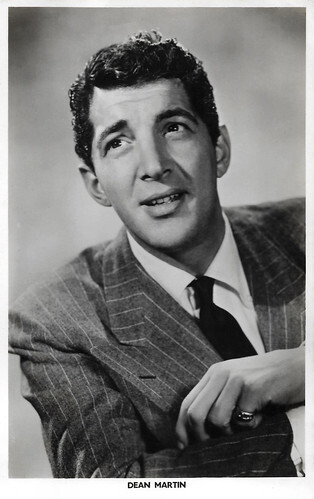
British Real Photograph postcard.
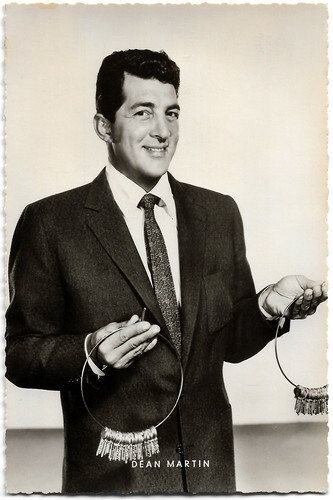
West-German postcard by Kunst und Bild, Berlin-Charlottenburg, no. A 1590. Photo: MGM.
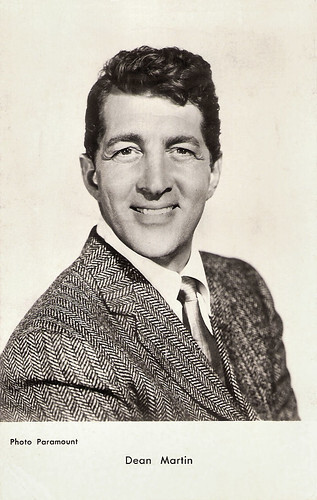
French postcard by Editions P.I., Paris, presented by Les Carbones Korès "Carboplane", no. 1075 A. Photo: Paramount.
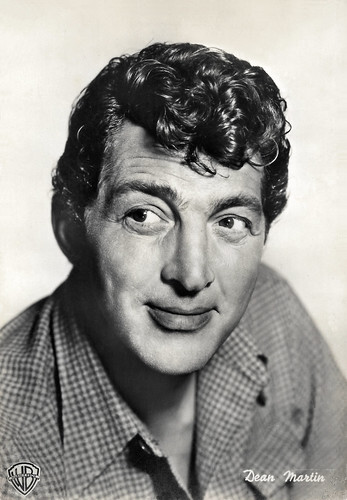
Italian postcard by Bromofoto, Milano, no. 1672. Photo: Warner Bros. Publicity portrait for Rio Bravo (Howard Hawks, 1959).
The Rat Pack
Many thought that Martin's career was on the decline without his partner, but to their surprise, Dean Martin went on to have a successful solo career. He made films that were often very different from those he made with Lewis and achieved great success, both in comedy and drama. In 1958, he got rave reviews for The Young Lions (Edward Dmytryk, 1958) with Marlon Brando and Montgomery Clift . He won more critical acclaim for his roles in Some Came Running (Vincente Minnelli, 1958).
In 1959, he played the complex role of the alcoholic Dude, John Wayne 's deputy in the Western Rio Bravo (Howard Hawks, 1959). Box office hits such as Rio Bravo (Howard Hawks, 1959) and Ocean's Eleven (Lewis Milestone, 1960) brought him international fame.
In the 1950s, Dean Martin also achieved international success as a singer. In 1954, he released 'That's Amore', one of his best-loved songs, written by his Italian-American friend and colleague Harry Warren. The song is also a declaration of affection for Naples and its traditions of pizza, wine, cuisine, and the tarantella. In 1956, he spent five weeks at number one in the US charts and four weeks in the UK Singles Chart with the single 'Memories are made of this'. His relaxed, warbling, crooning voice earned him dozens of hit singles, including some Italian songs, such as 'Innamorata', 'In Napoli', 'Simpatico', and 'Volare'.
He became one of the most popular acts in Las Vegas and was known for his friendship with fellow artists Frank Sinatra and Sammy Davis Jr., who together formed the Rat Pack. He starred in several films with the Rat Pack, including Ocean's 11 (Lewis Milestone, 1960), Sergeants 3 (John Sturges, 1962), and Robin and the 7 Hoods (Gordon Douglas, 1964). In the Rat Pack's appearances, Martin often played the role of a heavy drinker. But, as his son later revealed, what he drank on stage was not alcohol, but apple juice.
Between 1966 and 1969 he made a series of four films as secret agent Matt Helm, and from 1965 to 1974 he hosted his own weekly television show on NBC, The Dean Martin Show. The last of his 51 films was Cannonball Run II (Hal Needham, 1984), starring Burt Reynolds. He retired in 1988 after a concert tour with Sinatra and Sammy Davis Jr. his Rat Pack pals and friends. "The satisfaction I get from working with these two slackers is that we have more fun than the audience," Martin said of it.
He was married three times and had eight children, one of whom was adopted. His son Dean Paul Martin Jr. died in a plane crash in 1987. This was another blow to his health, but it did rekindle his friendship with Jerry Lewis , as Lewis unexpectedly attended Martin's son's funeral. After years of physical and mental decline, Dean Martin died of emphysema on Christmas Day 1995. He was buried in Westwood Cemetery in California.
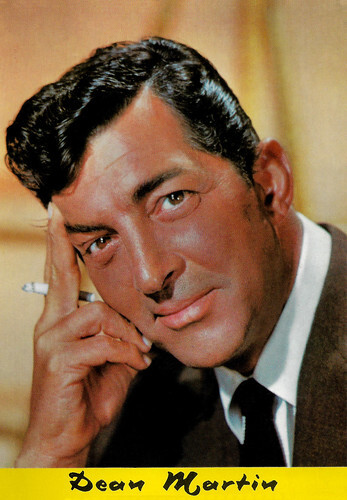
Spanish postcard by Bergas, no. 548.
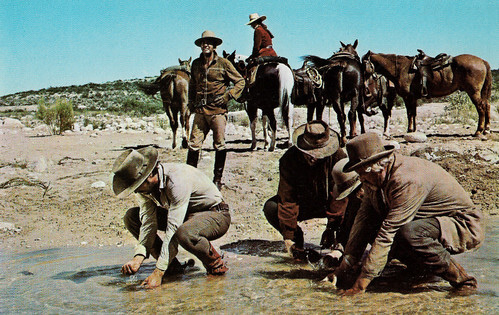
American postcard by Walcott & Sons, San Angelo, Texas, no. ICS-73697. Photo: Twentieth Century Fox. Dean Martin in Bandolero (Andrew V. McLaglen, 1968). Caption: Twentieth Century-Fox presents "Bandolero!" Starring James Stewart, Dean Martin, Raquel Welch, George Kennedy, and Andrew Prine. Robert L. Jacks produced with Andrew V. McLaglen directing. Dean Martin and his outlaw gang, with Raquel Welch as a hostage, stop at the Devil's River to fill their canteens, as they flee from a posse, in a scene from the movie "Bandolero!" This scene was shot on the Devil's River around Del Rio and Bracketville, Texas. The ones pictured are left to right - Will Greer, Clint Ritchie, Sean McClory, Tom Heaton, Dean Martin, and Raquel Welch. Most scenes were shot at Alamo Village near Bracketville and Del Rio, Texas. This a terrific border western.
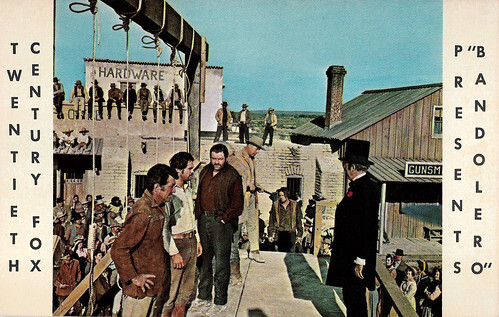
American postcard by Walcott & Sons, San Angelo, Texas, no. S-73742-1. Photo: Twentieth Century Fox. Dean Martin and James Stewart in Bandolero (Andrew V. McLaglen, 1968). Caption: Twentieth Century-Fox presents "Bandolero!" Starring James Stewart, George Kennedy and Andrew Prine. Robert L. Jacks produced with Andrew V. McLaglen directing. Scene is from 20th Century-Fox's "Bandolero!", which was filmed at Alamo Village on Shahan's Angus Ranch near Bracketville and Del Rio, Texas. James Stewart (in black top hat) looks over Dean Martin and his gang, all of whom he is supposed to hang. George Kennedy (with shotgun) covers Tom Heaston, last man to mount the scaffold. Behind Martin are Clint Ritchie, Sean McClory. The film is a top-budget Western with plenty of action.
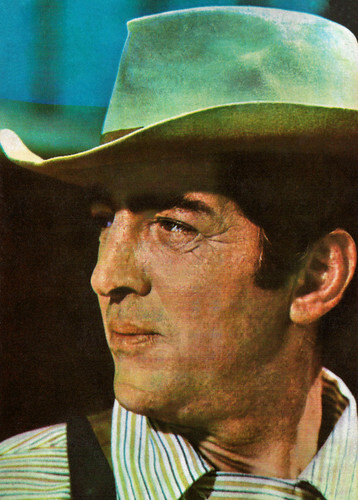
Romanian postcard by Casa Filmului Acin, no. 566. Dean Martin in Texas Across the River (Michael Gordon, 1966).
Sources: Wikipedia (Dutch and English), and .

British postcard in the Picturegoer Series, no. W 990. Photo: Paramount.

Dutch card. Dean Martin and Jerry Lewis .

French postcard in the Entr'acte series by Éditions Asphodèle. Mâcon, no. 006/7. Collection: B. Courtel / D.R. Dean Martin and Angie Dickinson in 1958 at the set of Rio Bravo (Howard Hawks, 1959). Caption: Dean Martin and his partner Angie Dickinson behind the camera for a break.

German postcard by Krüger, no. 902/193. Photo: Terb Agency. Sammy Davis Jr., Dean Martin, Peter Lawford, and Frank Sinatra .
A duo with Jerry Lewis
Dean Martin was born Dino Paul Crocetti in Steubenville, Ohio, in 1917. His parents were Gaetano Alfonso "Guy" Crocetti, an Italian immigrant and barber, and his Ohio-born wife, Angela (Barra) Crocetti. He spoke only Italian until age five. Martin came up the hard way, with such jobs as a boxer ("Kid Crochet"), a steel mill worker, a gas station worker, and a casino croupier/dealer.
He managed to establish himself as a singer in New York clubs under the stage name "Dean Martin". In order to have more chances to establish his career, Dino Paul Crocetti legally changed his name to a more American one and chose the surname "Martin" because it was an English version of the surname of the Italian tenor Nino Martini.
In 1946, he got his first ticket to stardom, as he teamed up with another hard worker who was also trying to succeed in Hollywood: Jerry Lewis . They first met at the Glass Hat Club in New York, where they both performed. The two artists formed a successful comedy duo, which lasted for about ten years. His first collaboration with Jerry Lewis was on 25 July 1946 at Club 500 in Atlantic City, and together they developed a successful comedy routine. They divided their show between songs, skits, with Lewis playing the "naughty boy" of comedy, i.e. improvised comedy.
The duo eventually found success and began a series of successful performances across the country, culminating in a show at New York's Copacabana nightclub. The act featured Lewis interrupting and annoying Martin as he tried to sing, with the two eventually chasing each other around the stage. The secret of the show's success, they both said, was that they ignored the audience and only tried to interact with each other, to make it as spontaneous as possible.
In 1949, the pair made their first film My Friend Irma (George Marshall, 1949) featuring Marie Wilson. Their joint television debut was in The Colgate Comedy Hour (1950), a variety show that they would also present occasionally between 1950 and 1955. They also had their own radio show. In 1951 they starred in the film hit At War with the Army (Hal Walker, 1950), which sent the team toward super-stardom. The thirteen films they made after that were based on the formula of this film.
The duo was to become one of Hollywood's truly great teams. Their agent, Abby Greshler, negotiated for them one of the best business deals in Hollywood history: despite receiving only $75,000 together from the profits of their films, Martin and Lewis were free to make one film a year as independents, which they would co-produce through York Productions, which they owned. They lasted 11 years together and starred in sixteen films, from My Friend Irma (George Marshall, 1949) to Hollywood or Bust (Frank Tashlin, 1956).
However, due to growing personal differences, the artistic partnership, and thus the collaboration with Lewis, was terminated on 24 July 1956. Frustration with the routine of their film scripts, which Paramount producer Hal Wallis wanted to keep as even as possible to maximise the couple's success, led Martin to become dissatisfied with the situation in which his career was being channelled. He became less and less enthusiastic about his work, which led to constant disagreements with Lewis. Martin even went so far as to declare that his partner "meant nothing to him but dollar signs".

British Real Photograph postcard.

West-German postcard by Kunst und Bild, Berlin-Charlottenburg, no. A 1590. Photo: MGM.

French postcard by Editions P.I., Paris, presented by Les Carbones Korès "Carboplane", no. 1075 A. Photo: Paramount.

Italian postcard by Bromofoto, Milano, no. 1672. Photo: Warner Bros. Publicity portrait for Rio Bravo (Howard Hawks, 1959).
The Rat Pack
Many thought that Martin's career was on the decline without his partner, but to their surprise, Dean Martin went on to have a successful solo career. He made films that were often very different from those he made with Lewis and achieved great success, both in comedy and drama. In 1958, he got rave reviews for The Young Lions (Edward Dmytryk, 1958) with Marlon Brando and Montgomery Clift . He won more critical acclaim for his roles in Some Came Running (Vincente Minnelli, 1958).
In 1959, he played the complex role of the alcoholic Dude, John Wayne 's deputy in the Western Rio Bravo (Howard Hawks, 1959). Box office hits such as Rio Bravo (Howard Hawks, 1959) and Ocean's Eleven (Lewis Milestone, 1960) brought him international fame.
In the 1950s, Dean Martin also achieved international success as a singer. In 1954, he released 'That's Amore', one of his best-loved songs, written by his Italian-American friend and colleague Harry Warren. The song is also a declaration of affection for Naples and its traditions of pizza, wine, cuisine, and the tarantella. In 1956, he spent five weeks at number one in the US charts and four weeks in the UK Singles Chart with the single 'Memories are made of this'. His relaxed, warbling, crooning voice earned him dozens of hit singles, including some Italian songs, such as 'Innamorata', 'In Napoli', 'Simpatico', and 'Volare'.
He became one of the most popular acts in Las Vegas and was known for his friendship with fellow artists Frank Sinatra and Sammy Davis Jr., who together formed the Rat Pack. He starred in several films with the Rat Pack, including Ocean's 11 (Lewis Milestone, 1960), Sergeants 3 (John Sturges, 1962), and Robin and the 7 Hoods (Gordon Douglas, 1964). In the Rat Pack's appearances, Martin often played the role of a heavy drinker. But, as his son later revealed, what he drank on stage was not alcohol, but apple juice.
Between 1966 and 1969 he made a series of four films as secret agent Matt Helm, and from 1965 to 1974 he hosted his own weekly television show on NBC, The Dean Martin Show. The last of his 51 films was Cannonball Run II (Hal Needham, 1984), starring Burt Reynolds. He retired in 1988 after a concert tour with Sinatra and Sammy Davis Jr. his Rat Pack pals and friends. "The satisfaction I get from working with these two slackers is that we have more fun than the audience," Martin said of it.
He was married three times and had eight children, one of whom was adopted. His son Dean Paul Martin Jr. died in a plane crash in 1987. This was another blow to his health, but it did rekindle his friendship with Jerry Lewis , as Lewis unexpectedly attended Martin's son's funeral. After years of physical and mental decline, Dean Martin died of emphysema on Christmas Day 1995. He was buried in Westwood Cemetery in California.

Spanish postcard by Bergas, no. 548.

American postcard by Walcott & Sons, San Angelo, Texas, no. ICS-73697. Photo: Twentieth Century Fox. Dean Martin in Bandolero (Andrew V. McLaglen, 1968). Caption: Twentieth Century-Fox presents "Bandolero!" Starring James Stewart, Dean Martin, Raquel Welch, George Kennedy, and Andrew Prine. Robert L. Jacks produced with Andrew V. McLaglen directing. Dean Martin and his outlaw gang, with Raquel Welch as a hostage, stop at the Devil's River to fill their canteens, as they flee from a posse, in a scene from the movie "Bandolero!" This scene was shot on the Devil's River around Del Rio and Bracketville, Texas. The ones pictured are left to right - Will Greer, Clint Ritchie, Sean McClory, Tom Heaton, Dean Martin, and Raquel Welch. Most scenes were shot at Alamo Village near Bracketville and Del Rio, Texas. This a terrific border western.

American postcard by Walcott & Sons, San Angelo, Texas, no. S-73742-1. Photo: Twentieth Century Fox. Dean Martin and James Stewart in Bandolero (Andrew V. McLaglen, 1968). Caption: Twentieth Century-Fox presents "Bandolero!" Starring James Stewart, George Kennedy and Andrew Prine. Robert L. Jacks produced with Andrew V. McLaglen directing. Scene is from 20th Century-Fox's "Bandolero!", which was filmed at Alamo Village on Shahan's Angus Ranch near Bracketville and Del Rio, Texas. James Stewart (in black top hat) looks over Dean Martin and his gang, all of whom he is supposed to hang. George Kennedy (with shotgun) covers Tom Heaston, last man to mount the scaffold. Behind Martin are Clint Ritchie, Sean McClory. The film is a top-budget Western with plenty of action.

Romanian postcard by Casa Filmului Acin, no. 566. Dean Martin in Texas Across the River (Michael Gordon, 1966).
Sources: Wikipedia (Dutch and English), and .
Published on April 21, 2022 22:00
April 20, 2022
Tino Rossi
The good-looking Corsican singer and film actor Tino Rossi (1907-1983) was one of the great romantic idols of his time. The quintessential ‘Latin lover’ sold over 300 million records and appeared in more than 25 film musicals. Rossi is the most popular personality to come from Corsica since Napoleon Bonaparte.
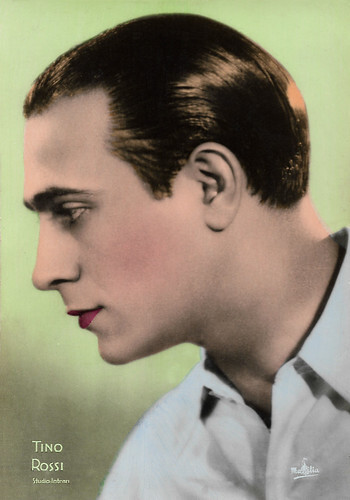
French postcard by Massilia. Photo: Studio Intran.
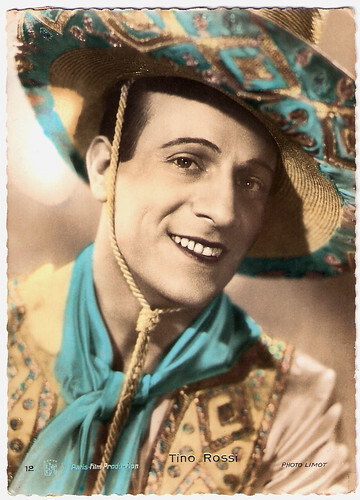
French postcard by Editions et Publications Cinematographiques (EPC), no. 12. Photo: Limot / Paris Film Production.
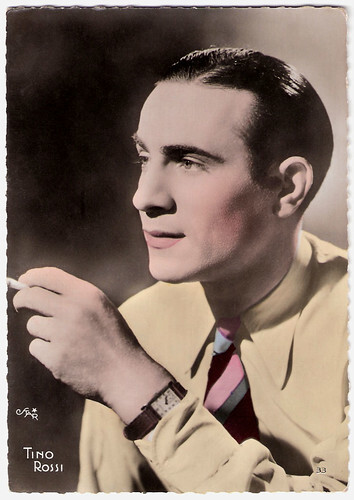
French postcard by Editions P.I., Paris, no. 33. Photo: Star.
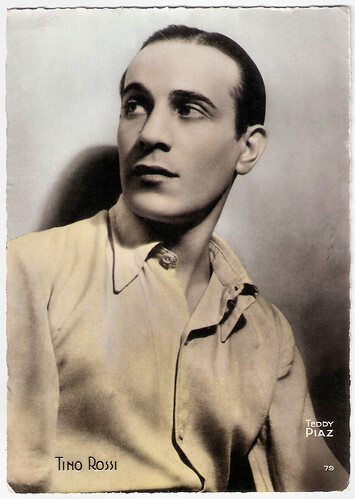
French postcard by O.P., Paris, no. 79. Photo: Teddy Piaz.
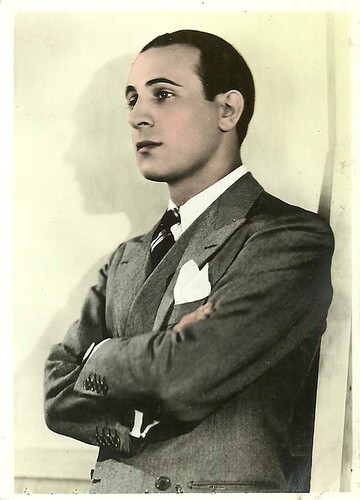
French postcard. The edges have been cut off but it looks like a Viny card. Written on the back: "1939 Avril" [April 1939].
Operatic Voice
Constantino Rossi was born as the third of eight children in a Corsican family in Ajaccio, France, in 1907.
He was gifted with an operatic voice. As a teenager, he played guitar and sang at a variety of small venues in his hometown before going on to perform in Marseilles and at resort clubs along the French Riviera.
He competed in amateur singing contests while working for a mortgage company to support himself. Though a failed marriage detoured him and his career briefly, eventually, a promoter saw Rossi performing and signed him in 1929 to a short tour circuit.
Although that and the two songs he recorded with Parlophone, 'O Ciuciarella' and 'Ninni Nanni', didn't bring him immediate success, in 1933 Columbia offered him the deal he wanted.
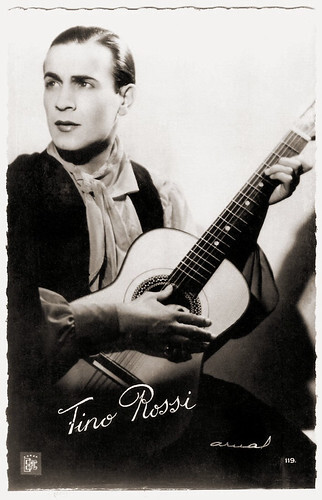
French postcard by Editions et Publications Cinématographiques, no. 119. Photo: Arnal / EPC.
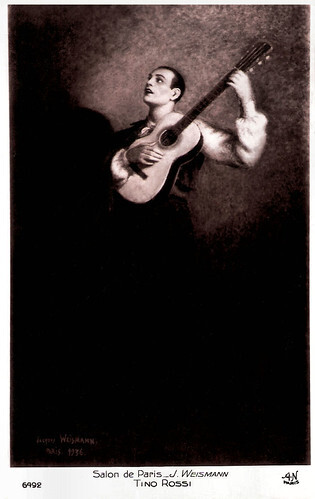
French postcard by A.N., Paris, no. 6492. Image: Jacques Weismann, 1936.
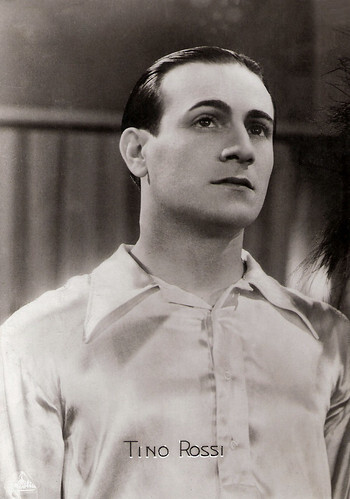
French card by Massilia.
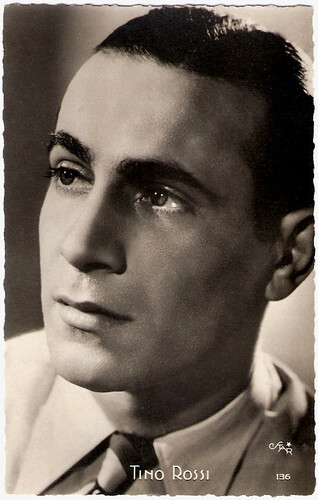
French postcard by Editions O.P., Paris, no. 136. Photo: Star.
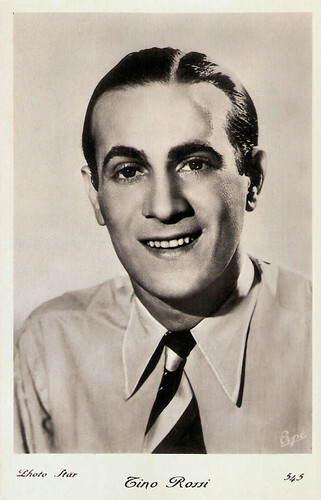
French postcard by Erpé, no. 545. Photo: Star.
Major Box Office Attraction
In 1934 Tino Rossi represented Corsica in La Parade de France, where he was met with much acclaim.
His fame truly commenced when he began starring in film musicals like Naples au Baiser de Feu/The Kiss of Fire (Augusto Genina, 1937) with Michel Simon and Mireille Balin .
His romantic ballads had women swooning and his art songs by Jules Massenet, Reynaldo Hahn, and other composers helped draw massive audiences wherever he performed.
Rossi's success was greatly aided by songwriter Vincent Scotto, who wrote his first hits and collaborated with him for many years.
Prior to World War II, Rossi was a major box office attraction in the French-speaking world but expanded his audience to America with a 1938 visit followed up by wartime tours across the USA and Canada.
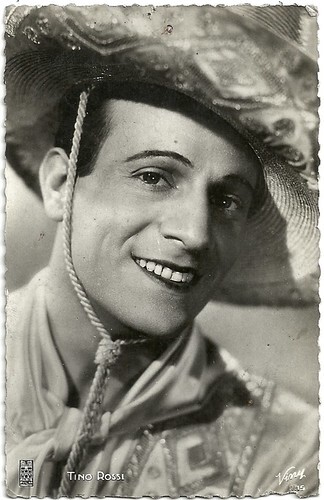
French postcard by Viny, no. 35. Photo: Paris Film Production.
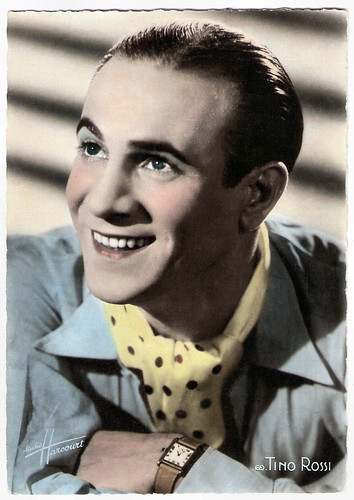
French postcard by SERP, Paris, no. 69. Photo: Studio Harcourt.
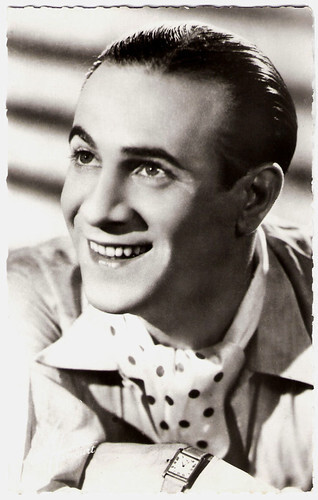
French postcard by Editions du Globe, Paris, no. 107. Photo: Studio Harcourt.
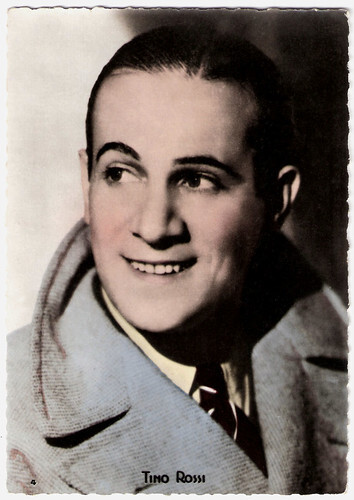
French postcard by Edition P.I., Paris, no. 4.
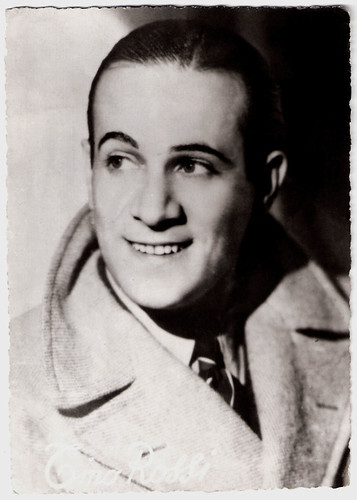
Vintage postcard.
Latin Lover
A ‘Latin lover’ persona made Tino Rossi a true film star. He began his film career in Les nuits moscovites/Moscow Nights (Alexis Granowsky, 1934) starring Annabella , but his first real success came with Marinella (Pierre Caron, 1936) with Yvette Lebon .
It was followed by Lumières de Paris/Lights of Paris (Richard Pottier, 1938) with Michèle Alfa , Fiévres/Fever (Jean Delannoy, 1942) opposite Jacqueline Delubac , and Le Soleil a toujours raison/The Sun Has Always a Reason (Pierre Billon, 1943) co-starring Charles Vanel .
All his films were musicals and capitalised on his success as a singer. During the occupation of France by Nazi Germany, Rossi's film career reached its peak, notably with Mon amour est près de toi/My Love Is For You (Richard Pottier, 1943) and L'île d'amour/The Isle of Love (Maurice Cram, 1944) with Josseline Gaël .
After the Liberation, the French authorities reproached him for associating with the French Gestapo, but most importantly for actively supporting collaborationist causes such as the LVF (Légion des Volontaires Français) who sent French volunteers to work in German factories.
He was arrested in October 1944 and spent three weeks in Fresnes prison (near Paris). Following a trial in 1945, his sentence was relatively light unlike that of colleagues as Arletty , Mireille Balin, and Josseline Gaël . Rossi received a retrospective and largely symbolic work suspension.
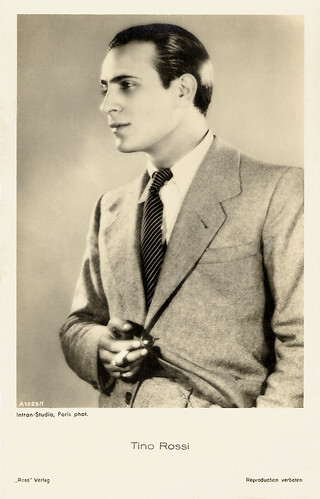
German postcard by Ross Verlag, no. A 1025/1, 1937-1938. Photo: Intran-Studio, Paris.
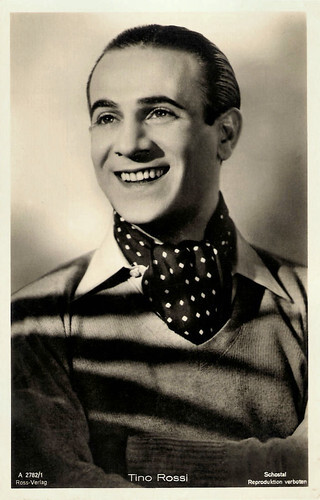
German postcard by Ross Verlag, no. A 2782/1, 1939-1940. Photo: Schostal.
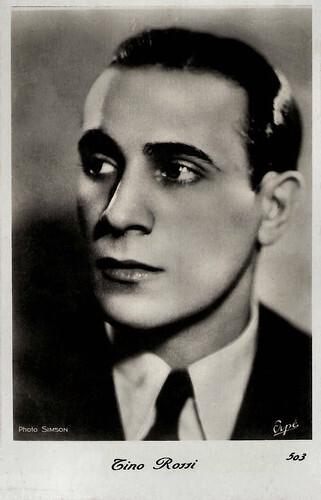
French postcard by Erpé, no. 503. Photo: Simson.
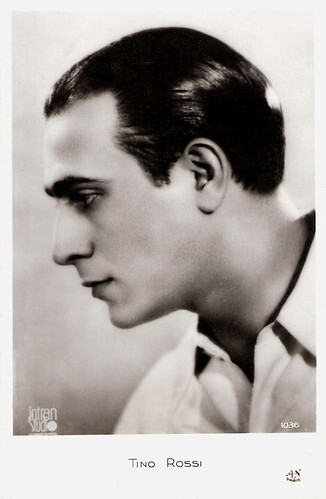
French postcard by A.N., Paris, no. 1036. Photo: Intran Studio, Paris.
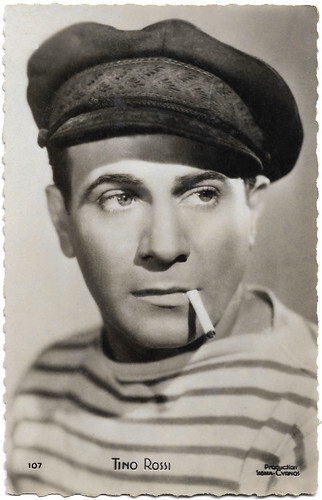
French postcard by Editions P.I., no. 107. Photo: Sigma-Cyrnos. Tino Rossi in L'île d'amour/The island of love (Maurice Cam, 1944).
Overwhelming popularity
Tino Rossi's post-war films include Sérénade aux nuages/Song of the Clouds (André Cayatte, 1946), Destins/Destinies (Richard Pottier, 1946) with Mila Parély , Le Gardian/The Guardian (Jean de Marguenat, 1946), and Marlène (Pierre de Hérain, 1949).
Destins/Destinies (1946) contained his most popular song, 'Petit Papa Noël', which sold more than thirty million copies worldwide. In 1947 he married Lilia Vetti, a young dancer and actress he had met while making Le Chant de l'exilé/The Song of the Exile (André Hugon, 1943). They would have a son, Laurent, in a marriage that lasted for a lifetime.
In 1954, he joined the all-star cast of Si Versailles m'était conté/Affairs in Versailles (Sacha Guitry, 1954), the history of the palace of Versailles from its founding to the present. James Travers at Films de France: "Towards the end of his career, writer and film director Sacha Guitry made three major historical films, each of which earned him critical acclaim and each of which has retained enduring popularity. Si Versailles m’était conté is arguably the best of the three, although its sister films Si Paris nous était conté and Napoléon are also highly regarded by many. All three films are lavish, well-scripted episodic historical films, featuring a dizzying cast of France’s best-known actors."
In 1955 Tino Rossi starred in the stage operetta 'Méditerranée', and in the following years, he continued performing around France and the world. His career also evolved into the television era, appearing in a number of popular variety shows. By the 1960s, Rossi largely retired from performing as he passed his 50th birthday and rock-and-roll made his style of music obsolete.
In 1982, President François Mitterrand named Tino Rossi a Commander of the Legion of Honor for his contribution to France and its culture. That same year the 75-year-old singer gave his last public performance at the Casino de Paris, a show that popular demand turned into a three-month stint. Their overwhelming popularity even earned the performer a new recording contract with Pathé Marconi. However, soon after his farewell concerts, Tino Rossi died of pancreatic cancer in his home in Neilly-sur-Seine, one of the Parisian suburbs, in 1983.
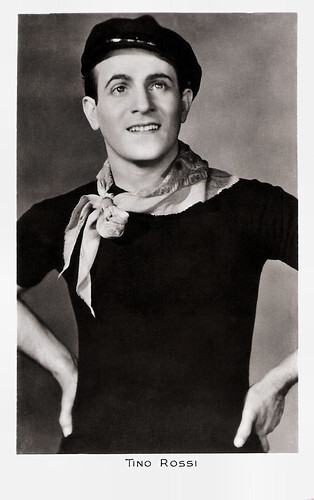
French postcard.
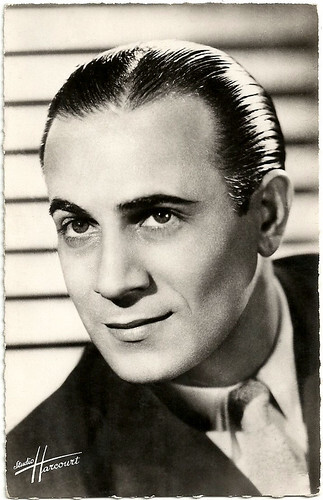
French postcard by Editions du Globe, Paris. Photo: Studio Harcourt.
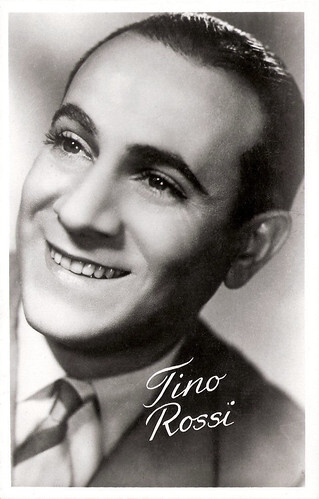
Dutch postcard by Uitg. Takken, Utrecht, no. AX 333.
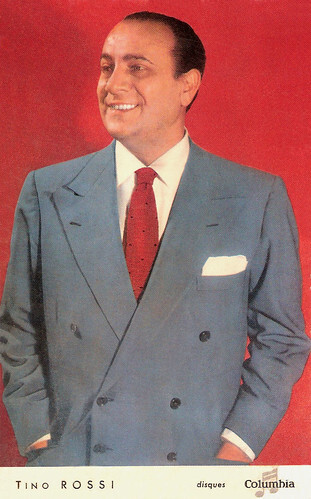
French postcard by JPH. Photo: Disques Columbia.
Sources: James Travers (Films de France), Marisa Brown (AllMusic), Wikipedia, and .

French postcard by Massilia. Photo: Studio Intran.

French postcard by Editions et Publications Cinematographiques (EPC), no. 12. Photo: Limot / Paris Film Production.

French postcard by Editions P.I., Paris, no. 33. Photo: Star.

French postcard by O.P., Paris, no. 79. Photo: Teddy Piaz.

French postcard. The edges have been cut off but it looks like a Viny card. Written on the back: "1939 Avril" [April 1939].
Operatic Voice
Constantino Rossi was born as the third of eight children in a Corsican family in Ajaccio, France, in 1907.
He was gifted with an operatic voice. As a teenager, he played guitar and sang at a variety of small venues in his hometown before going on to perform in Marseilles and at resort clubs along the French Riviera.
He competed in amateur singing contests while working for a mortgage company to support himself. Though a failed marriage detoured him and his career briefly, eventually, a promoter saw Rossi performing and signed him in 1929 to a short tour circuit.
Although that and the two songs he recorded with Parlophone, 'O Ciuciarella' and 'Ninni Nanni', didn't bring him immediate success, in 1933 Columbia offered him the deal he wanted.

French postcard by Editions et Publications Cinématographiques, no. 119. Photo: Arnal / EPC.

French postcard by A.N., Paris, no. 6492. Image: Jacques Weismann, 1936.

French card by Massilia.

French postcard by Editions O.P., Paris, no. 136. Photo: Star.

French postcard by Erpé, no. 545. Photo: Star.
Major Box Office Attraction
In 1934 Tino Rossi represented Corsica in La Parade de France, where he was met with much acclaim.
His fame truly commenced when he began starring in film musicals like Naples au Baiser de Feu/The Kiss of Fire (Augusto Genina, 1937) with Michel Simon and Mireille Balin .
His romantic ballads had women swooning and his art songs by Jules Massenet, Reynaldo Hahn, and other composers helped draw massive audiences wherever he performed.
Rossi's success was greatly aided by songwriter Vincent Scotto, who wrote his first hits and collaborated with him for many years.
Prior to World War II, Rossi was a major box office attraction in the French-speaking world but expanded his audience to America with a 1938 visit followed up by wartime tours across the USA and Canada.

French postcard by Viny, no. 35. Photo: Paris Film Production.

French postcard by SERP, Paris, no. 69. Photo: Studio Harcourt.

French postcard by Editions du Globe, Paris, no. 107. Photo: Studio Harcourt.

French postcard by Edition P.I., Paris, no. 4.

Vintage postcard.
Latin Lover
A ‘Latin lover’ persona made Tino Rossi a true film star. He began his film career in Les nuits moscovites/Moscow Nights (Alexis Granowsky, 1934) starring Annabella , but his first real success came with Marinella (Pierre Caron, 1936) with Yvette Lebon .
It was followed by Lumières de Paris/Lights of Paris (Richard Pottier, 1938) with Michèle Alfa , Fiévres/Fever (Jean Delannoy, 1942) opposite Jacqueline Delubac , and Le Soleil a toujours raison/The Sun Has Always a Reason (Pierre Billon, 1943) co-starring Charles Vanel .
All his films were musicals and capitalised on his success as a singer. During the occupation of France by Nazi Germany, Rossi's film career reached its peak, notably with Mon amour est près de toi/My Love Is For You (Richard Pottier, 1943) and L'île d'amour/The Isle of Love (Maurice Cram, 1944) with Josseline Gaël .
After the Liberation, the French authorities reproached him for associating with the French Gestapo, but most importantly for actively supporting collaborationist causes such as the LVF (Légion des Volontaires Français) who sent French volunteers to work in German factories.
He was arrested in October 1944 and spent three weeks in Fresnes prison (near Paris). Following a trial in 1945, his sentence was relatively light unlike that of colleagues as Arletty , Mireille Balin, and Josseline Gaël . Rossi received a retrospective and largely symbolic work suspension.

German postcard by Ross Verlag, no. A 1025/1, 1937-1938. Photo: Intran-Studio, Paris.

German postcard by Ross Verlag, no. A 2782/1, 1939-1940. Photo: Schostal.

French postcard by Erpé, no. 503. Photo: Simson.

French postcard by A.N., Paris, no. 1036. Photo: Intran Studio, Paris.

French postcard by Editions P.I., no. 107. Photo: Sigma-Cyrnos. Tino Rossi in L'île d'amour/The island of love (Maurice Cam, 1944).
Overwhelming popularity
Tino Rossi's post-war films include Sérénade aux nuages/Song of the Clouds (André Cayatte, 1946), Destins/Destinies (Richard Pottier, 1946) with Mila Parély , Le Gardian/The Guardian (Jean de Marguenat, 1946), and Marlène (Pierre de Hérain, 1949).
Destins/Destinies (1946) contained his most popular song, 'Petit Papa Noël', which sold more than thirty million copies worldwide. In 1947 he married Lilia Vetti, a young dancer and actress he had met while making Le Chant de l'exilé/The Song of the Exile (André Hugon, 1943). They would have a son, Laurent, in a marriage that lasted for a lifetime.
In 1954, he joined the all-star cast of Si Versailles m'était conté/Affairs in Versailles (Sacha Guitry, 1954), the history of the palace of Versailles from its founding to the present. James Travers at Films de France: "Towards the end of his career, writer and film director Sacha Guitry made three major historical films, each of which earned him critical acclaim and each of which has retained enduring popularity. Si Versailles m’était conté is arguably the best of the three, although its sister films Si Paris nous était conté and Napoléon are also highly regarded by many. All three films are lavish, well-scripted episodic historical films, featuring a dizzying cast of France’s best-known actors."
In 1955 Tino Rossi starred in the stage operetta 'Méditerranée', and in the following years, he continued performing around France and the world. His career also evolved into the television era, appearing in a number of popular variety shows. By the 1960s, Rossi largely retired from performing as he passed his 50th birthday and rock-and-roll made his style of music obsolete.
In 1982, President François Mitterrand named Tino Rossi a Commander of the Legion of Honor for his contribution to France and its culture. That same year the 75-year-old singer gave his last public performance at the Casino de Paris, a show that popular demand turned into a three-month stint. Their overwhelming popularity even earned the performer a new recording contract with Pathé Marconi. However, soon after his farewell concerts, Tino Rossi died of pancreatic cancer in his home in Neilly-sur-Seine, one of the Parisian suburbs, in 1983.

French postcard.

French postcard by Editions du Globe, Paris. Photo: Studio Harcourt.

Dutch postcard by Uitg. Takken, Utrecht, no. AX 333.

French postcard by JPH. Photo: Disques Columbia.
Sources: James Travers (Films de France), Marisa Brown (AllMusic), Wikipedia, and .
Published on April 20, 2022 22:00
April 19, 2022
I sette peccati capitali - L'accidia (1919)
Italian diva Francesca Bertini starred in a silent film series called I sette peccati capitali (The Seven Mortal Sins), based on Eugène Sue's popular novel 'Les sept péchés capitaux'. She produced the series with her own production company Bertini Film in association with Caesar Film. Earlier, EFSP presented a post on L'orgoglio/Pride a.k.a. La superbia (Edoardo Bencivenga, 1918) with 'Cromos', coloured collector cards, that were made in Spain as a supplement for the chocolate boxes of Chocolate Imperial. Today Ivo Blom presents another part of this series, L'accidia/Acedia (Alfredo De Antoni, 1919), released in Spain as Pereza, for which Chocolate Imperial also produced a series of 10 collectors cards. In Ivo's collection, one of the cards is still missing.
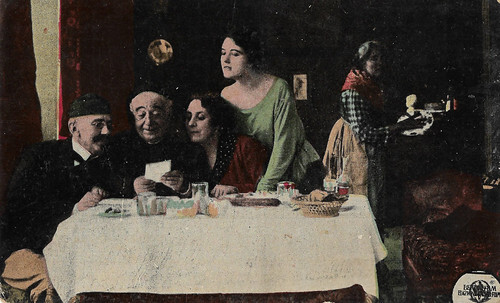
Spanish cromo by Chocolate Imperial in the Series 'Los siete pecados capitales' (The Seven Capital Sins), no. 1. Photo: Caesar Film / Spanish distr. J. Gurgui, Barcelona. Camillo De Riso and Francesca Bertini in L'accidia/Acedia (Alfredo De Antoni, 1919).
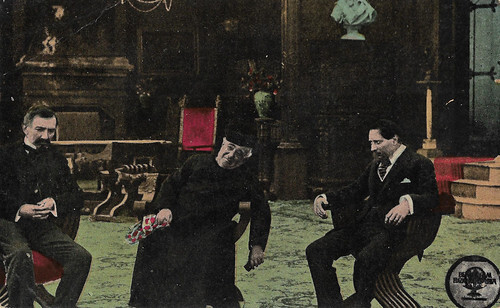
Spanish cromo by Chocolate Imperial in the Series 'Los siete pecados capitales' (The Seven Capital Sins), no. 2. Photo: Caesar Film / Spanish distr. J. Gurgui, Barcelona. Camillo De Riso and two unidentified actors in L'accidia/Acedia (Alfredo De Antoni, 1919).
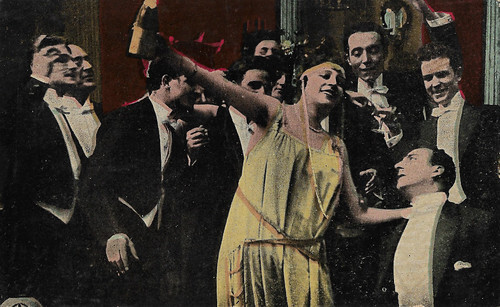
Spanish cromo by Chocolate Imperial in the Series 'Los siete pecados capitales' (The Seven Capital Sins), no. 3. Photo: Caesar Film / Spanish distr. J. Gurgui, Barcelona. Unknown actress and possibly down, right Livio Pavanelli in L'accidia/Acedia (Alfredo De Antoni, 1919).
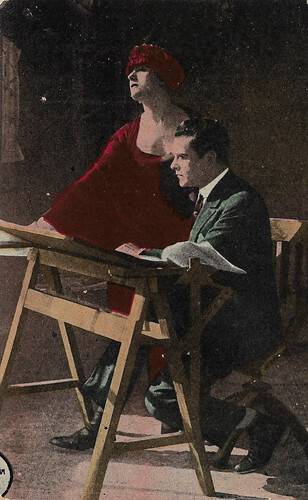
Spanish cromo by Chocolate Imperial in the Series 'Los siete pecados capitales' (The Seven Capital Sins), no. 4. Photo: Caesar Film / Spanish distr. J. Gurgui, Barcelona. Francesca Bertini and Livio Pavanelli in L'accidia/Acedia (Alfredo De Antoni, 1919).
Genuinely looking and acting discretely, even in dramatic scenes
It is nine years since Octavio Fortis (Guido Trento) has left his natal village. He has enjoyed city life while becoming an energetic industrial engineer. When returning full of nostalgia to his village, he meets the beautiful but inert Bianca ( Francesca Bertini ), who has escaped her house, always peopled by the sleepy trio of her father, the pharmacist Fanelli, the village priest Alfonso Procacci ( Camillo De Riso ), and the majordomos of the local castle.
The two young people fall in love. Meanwhile, the priest is setting up a marriage between Bianca and Duke Luciano ( Livio Pavanelli ), the owner of the castle. Bianca first rebels but then gives in and marries the duke. She blames the duke's inertia on the castle and convinces him to move to the city to enjoy the high life there (to which the duke is insensible).
There she meets Manuel, Count of the Antilles, who impresses everyone with his fame and fortune. Yet, he proves to be a reckless womaniser. When also Octavio pursuits her, and the two meet again at a ball, rekindling their flame, Bianca fears for her marriage and wants to go back to the castle and the quiet countryside.
Yet, to Bianca's horror, the duke also invites his friend the count, who again starts to pursuit her, makes a deal with the majordomos and even gets the key to the house. He blackmails Bianca because of her talks to Octavio. He also challenges Octavio to a duel, but the latter refuses such nonsense. The count, therefore, sets a trap, warning the Duke his wife is about to commit adultery and pressing him to kill the rival.
When the two men catch the couple at Octavio's house, the inert duke has the first anger explosion of his life. Still, he cannot shoot people, so the count points at Octavio with his gun. Yet, the engineer throws himself on him. Only when disarming him, he accidentally shoots the duke. Bianca is in tears. Days after, she will reunite with Octavio, and find her true life.
The description above of L'accidia (1919) is based on the texts of the cromos. The plot in Vittorio Martinelli's Il cinema muto italiano 1919, is much shorter but adds that Octavio is planning to redevelop the village by use of hydroelectricity.
L'accidia was scripted by George Ruby, cinematographed by Giuseppe Filippa, while sets were by Alfredo Manzi. Other actors were Alberto Albertini, Luigi Cigoli, and Francesco Gennaro. The Roman premiere took place on 1 November 1919. The journal Cine-Fono judged the story and direction as okay, but praised Bertini, who "for once looked genuine, was acting discretely (even in dramatic scenes) and didn't twist her mouth for once".
I sette peccati capitali is based on the Eugène Sue novel series Les sept pêchés capitaux (1847-1852). The complete series consists of: L'orgoglio (pride), La gola (gluttony), L'ira (wrath) and L'avarizia (greed) (all 1918), L'Invidia (envy), L'accidia (acedia) and La lussuria (lust) (all 1919). Critics didn't like the series at the time but audiences flocked to see it. The film series was believed lost until found at the Prague Film Institute (Ceskoslovensky Filmovy Archiv). It was carefully restored including the original tinting. The first two restorations, L'avarizia and L'orgoglio, were shown at the festival Il Cinema Ritrovato in Bologna in 1991 and the complete series was shown there in 2003.

Spanish cromo by Chocolate Imperial in the Series 'Los siete pecados capitales' (The Seven Capital Sins), no. 5. Photo: Caesar Film / Spanish distr. J. Gurgui, Barcelona. Francesca Bertini , Livio Pavanelli and Guido Trento in L'accidia/Acedia (Alfredo De Antoni, 1919).
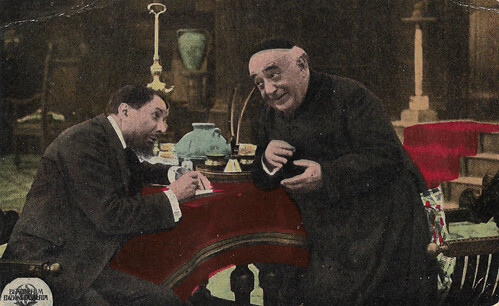
Spanish cromo by Chocolate Imperial in the Series 'Los siete pecados capitales' (The Seven Capital Sins), no. 6. Photo: Caesar Film / Spanish distr. J. Gurgui, Barcelona. Camillo de Riso and unknown actor in L'accidia/Acedia (Alfredo De Antoni, 1919).
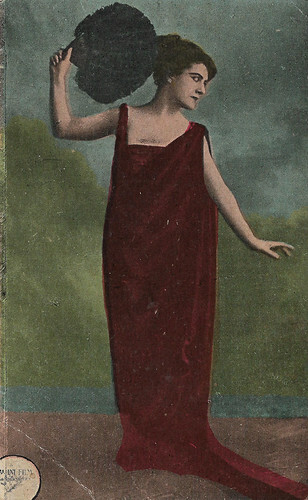
Spanish cromo by Chocolate Imperial in the Series 'Los siete pecados capitales' (The Seven Capital Sins), no. 7. Photo: Caesar Film / Spanish distr. J. Gurgui, Barcelona. Francesca Bertini in L'accidia/Acedia (Alfredo De Antoni, 1919).
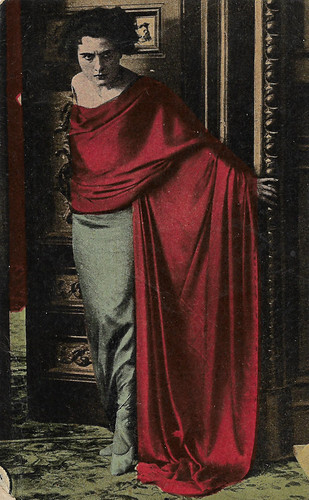
Spanish cromo by Chocolate Imperial in the Series 'Los siete pecados capitales' (The Seven Capital Sins), no. 9. Photo: Caesar Film / Spanish distr. J. Gurgui, Barcelona. Francesca Bertini in L'accidia/Acedia (Alfredo De Antoni, 1919).
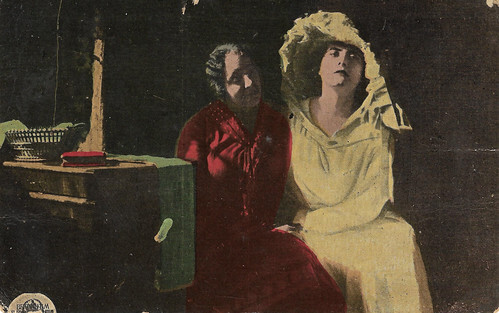
Spanish cromo by Chocolate Imperial in the Series 'Los siete pecados capitales' (The Seven Capital Sins), no. 10. Photo: Caesar Film / Spanish distr. J. Gurgui, Barcelona. Francesca Bertini in L'accidia/Acedia (Alfredo De Antoni, 1919).
Sources: Vittorio Martinelli (Il cinema muto italiano 1919. I film del dopoguerra - Italian), and IMDb.

Spanish cromo by Chocolate Imperial in the Series 'Los siete pecados capitales' (The Seven Capital Sins), no. 1. Photo: Caesar Film / Spanish distr. J. Gurgui, Barcelona. Camillo De Riso and Francesca Bertini in L'accidia/Acedia (Alfredo De Antoni, 1919).

Spanish cromo by Chocolate Imperial in the Series 'Los siete pecados capitales' (The Seven Capital Sins), no. 2. Photo: Caesar Film / Spanish distr. J. Gurgui, Barcelona. Camillo De Riso and two unidentified actors in L'accidia/Acedia (Alfredo De Antoni, 1919).

Spanish cromo by Chocolate Imperial in the Series 'Los siete pecados capitales' (The Seven Capital Sins), no. 3. Photo: Caesar Film / Spanish distr. J. Gurgui, Barcelona. Unknown actress and possibly down, right Livio Pavanelli in L'accidia/Acedia (Alfredo De Antoni, 1919).

Spanish cromo by Chocolate Imperial in the Series 'Los siete pecados capitales' (The Seven Capital Sins), no. 4. Photo: Caesar Film / Spanish distr. J. Gurgui, Barcelona. Francesca Bertini and Livio Pavanelli in L'accidia/Acedia (Alfredo De Antoni, 1919).
Genuinely looking and acting discretely, even in dramatic scenes
It is nine years since Octavio Fortis (Guido Trento) has left his natal village. He has enjoyed city life while becoming an energetic industrial engineer. When returning full of nostalgia to his village, he meets the beautiful but inert Bianca ( Francesca Bertini ), who has escaped her house, always peopled by the sleepy trio of her father, the pharmacist Fanelli, the village priest Alfonso Procacci ( Camillo De Riso ), and the majordomos of the local castle.
The two young people fall in love. Meanwhile, the priest is setting up a marriage between Bianca and Duke Luciano ( Livio Pavanelli ), the owner of the castle. Bianca first rebels but then gives in and marries the duke. She blames the duke's inertia on the castle and convinces him to move to the city to enjoy the high life there (to which the duke is insensible).
There she meets Manuel, Count of the Antilles, who impresses everyone with his fame and fortune. Yet, he proves to be a reckless womaniser. When also Octavio pursuits her, and the two meet again at a ball, rekindling their flame, Bianca fears for her marriage and wants to go back to the castle and the quiet countryside.
Yet, to Bianca's horror, the duke also invites his friend the count, who again starts to pursuit her, makes a deal with the majordomos and even gets the key to the house. He blackmails Bianca because of her talks to Octavio. He also challenges Octavio to a duel, but the latter refuses such nonsense. The count, therefore, sets a trap, warning the Duke his wife is about to commit adultery and pressing him to kill the rival.
When the two men catch the couple at Octavio's house, the inert duke has the first anger explosion of his life. Still, he cannot shoot people, so the count points at Octavio with his gun. Yet, the engineer throws himself on him. Only when disarming him, he accidentally shoots the duke. Bianca is in tears. Days after, she will reunite with Octavio, and find her true life.
The description above of L'accidia (1919) is based on the texts of the cromos. The plot in Vittorio Martinelli's Il cinema muto italiano 1919, is much shorter but adds that Octavio is planning to redevelop the village by use of hydroelectricity.
L'accidia was scripted by George Ruby, cinematographed by Giuseppe Filippa, while sets were by Alfredo Manzi. Other actors were Alberto Albertini, Luigi Cigoli, and Francesco Gennaro. The Roman premiere took place on 1 November 1919. The journal Cine-Fono judged the story and direction as okay, but praised Bertini, who "for once looked genuine, was acting discretely (even in dramatic scenes) and didn't twist her mouth for once".
I sette peccati capitali is based on the Eugène Sue novel series Les sept pêchés capitaux (1847-1852). The complete series consists of: L'orgoglio (pride), La gola (gluttony), L'ira (wrath) and L'avarizia (greed) (all 1918), L'Invidia (envy), L'accidia (acedia) and La lussuria (lust) (all 1919). Critics didn't like the series at the time but audiences flocked to see it. The film series was believed lost until found at the Prague Film Institute (Ceskoslovensky Filmovy Archiv). It was carefully restored including the original tinting. The first two restorations, L'avarizia and L'orgoglio, were shown at the festival Il Cinema Ritrovato in Bologna in 1991 and the complete series was shown there in 2003.

Spanish cromo by Chocolate Imperial in the Series 'Los siete pecados capitales' (The Seven Capital Sins), no. 5. Photo: Caesar Film / Spanish distr. J. Gurgui, Barcelona. Francesca Bertini , Livio Pavanelli and Guido Trento in L'accidia/Acedia (Alfredo De Antoni, 1919).

Spanish cromo by Chocolate Imperial in the Series 'Los siete pecados capitales' (The Seven Capital Sins), no. 6. Photo: Caesar Film / Spanish distr. J. Gurgui, Barcelona. Camillo de Riso and unknown actor in L'accidia/Acedia (Alfredo De Antoni, 1919).

Spanish cromo by Chocolate Imperial in the Series 'Los siete pecados capitales' (The Seven Capital Sins), no. 7. Photo: Caesar Film / Spanish distr. J. Gurgui, Barcelona. Francesca Bertini in L'accidia/Acedia (Alfredo De Antoni, 1919).

Spanish cromo by Chocolate Imperial in the Series 'Los siete pecados capitales' (The Seven Capital Sins), no. 9. Photo: Caesar Film / Spanish distr. J. Gurgui, Barcelona. Francesca Bertini in L'accidia/Acedia (Alfredo De Antoni, 1919).

Spanish cromo by Chocolate Imperial in the Series 'Los siete pecados capitales' (The Seven Capital Sins), no. 10. Photo: Caesar Film / Spanish distr. J. Gurgui, Barcelona. Francesca Bertini in L'accidia/Acedia (Alfredo De Antoni, 1919).
Sources: Vittorio Martinelli (Il cinema muto italiano 1919. I film del dopoguerra - Italian), and IMDb.
Published on April 19, 2022 22:00
April 18, 2022
Catherine Spaak (1945-2022)
Last Sunday, on 17 April 2022, French actress and singer Catherine Spaak (1945) passed away. Who was this now forgotten actress? She started as a Lolita-like vamp in Italian films of the early 1960s, made records and became a teenage star. She played in several classic Italian comedies, was a popular TV host and wrote books. Spaak appeared in some 100 films.

Italian postcard by Rotalfoto (Rotalcolor), Milano, no. 244.

Romanian postcard by Casa Filmului Acin, no. 519.
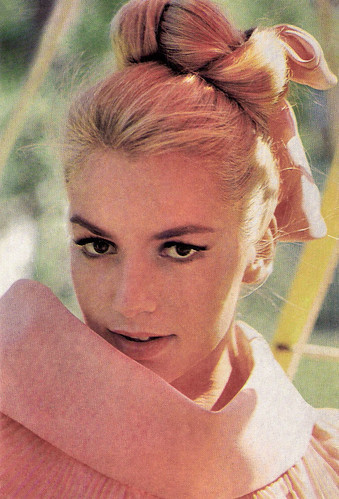
Romanian postcard by Casa Filmului Acin, no. 91.
The niece of the Belgian prime minister
Catherine Spaak was born in Boulogne-Billancourt, France in 1945. Her father was the Belgian critic and screenwriter Charles Spaak, her mother the actress Claudie Clèves and her sister is actress-photographer Agnès Spaak.
As a teenager, Catherine started her career with small roles in French films like the short L’hiver/The winter (Jacques Gautier, 1959) and the thriller Le Trou/Nightwatch (Jacques Becker, 1960).
When she moved to Italy later that year, her father introduced her to film director Alberto Lattuada, who cast her in his film I dolci inganni/Sweet Deceptions (Alberto Lattuada, 1960). That coming of age film made her a star in Italy. She played a young Roman girl in love, who spends the day observing other lovers' behaviours and considering whether she is ready to jump.
J.C. Mohsen at IMDb : “This film's unpredictability is refreshing. Whether written or filmed, coming-of-age stories often fail to surprise or intrigue the audience. In I Dolci Inganni, most characters seem at first to be crazily entertaining walking clichés, but they later astonish the audience by revealing their depth and their inner struggles.”
From age 15 to 18, Spaak was the lead actress in a dozen films, including La voglia matta/Crazy Desire (Luciano Salce, 1961) opposite Ugo Tognazzi , the classic comedy Il sorpasso/The Easy Life (Dino Risi, 1962) with Vittorio Gassman , La parmigiana/The Girl from Parma (Antonio Pietrangeli, 1963) with Nino Manfredi , and the Alberto Moravia adaptation La noia/The Empty Canvas (Damiano Damiani, 1963) with Horst Buchholz and Bette Davis .
For her performance in La noia she was awarded the David di Donatello, the Italian Oscar, in 1964. Spaak often played the Lolita-type who seduced men, and the Italian scandal press wrote about herself in that way. In their articles, journalists always included that she was the niece of the Belgian prime minister, Paul-Henri Spaak.

Italian postcard by Rotalfoto, Milano, no. 194.
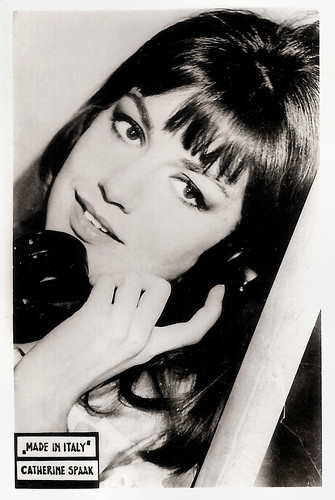
Small Romanian collectors card. Photo: Catherine Spaak in Made in Italy (Nanni Loy, 1965).
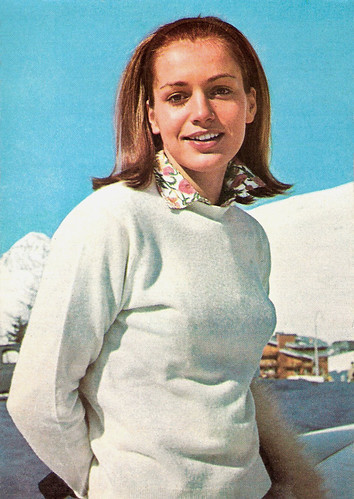
Italian postcard by Edizione diesse.
Highlights of the Commedia all'Italiana
Catherine Spaak’s screen success, combined with her love of singing and guitar playing, led to an offer from the Ricordi label in 1962. She recorded covers of Françoise Hardy's originals and songs in Hardy’s style.
Ready steady girls! , the site on Europe’s fab female singers of the 1960s in their bio: “Perdono – written by Gino Paoli (who had worked with stars such as Mina ) and arranged by Ennio Morricone – was issued as her debut single and swiftly made the Italian top 20.
Vocally, Catherine drew comparisons with France’s newest star, Françoise Hardy , so Ricordi opted to have their young signing record a couple of Hardy songs for the Italian market. Issued in 1963, the bilingual 'Tous les garçons et les filles' (Quelli della mia età) – backed with J’ai jeté mon coeur (Ho scherzato con il cuore) – gave Hardy’s original a run for its money, reaching number seven in September 1963 and confirming Catherine as a new star.”
In 1964, she returned to France to appear in La Ronde (Roger Vadim, 1964) and the war drama Week-end à Zuydcoote/Weekend at Dunkirk (Henri Verneuil, 1964) starring Jean-Paul Belmondo .
Back in Italy she played in some more highlights of the Commedia all'Italiana such as L'armata Brancaleone/Brancaleone's Army (Mario Monicelli, 1965) featuring Vittorio Gassman , and Made in Italy (Nanni Loy, 1965).
Other notable appearances include L'uomo dei cinque palloni/Break up (Marco Ferreri, 1965) starring Marcello Mastroianni , and La matriarca/The Libertine (Pasquale Festa Campanile, 1968) with Jean-Louis Trintignant .
In 1967 she went to Hollywood to play Rod Taylor’s love interest in Hotel (Richard Quine, 1967), based on the novel by Arthur Hailey. Hal Erickson at AllMovie : “Once she came to Hollywood, however, Spaak was packaged and promoted as just another foreign starlet, interchangeable with Claudia Cardinale , Camilla Sparv, Elke Sommer and the rest of the batch.”
The result was not a success and soon she was back in Italy. Two years later she did a cameo in another Hollywood production, If It's Tuesday, This Must Be Belgium (Mel Stuart, 1969).
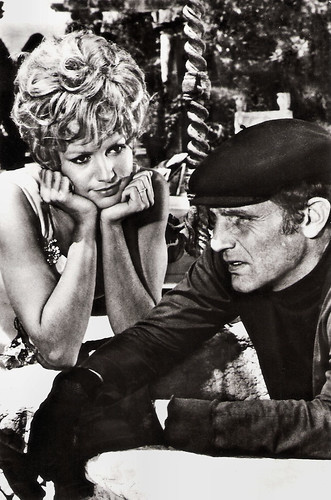
Romanian postcard by Casa Filmului Acin, no. 25. Photo: Catherine Spaak and Philippe Leroy in the crime comedy La notte è fatta per... rubare/Night Is Made for Stealing (Giorgio Capitani, 1968).
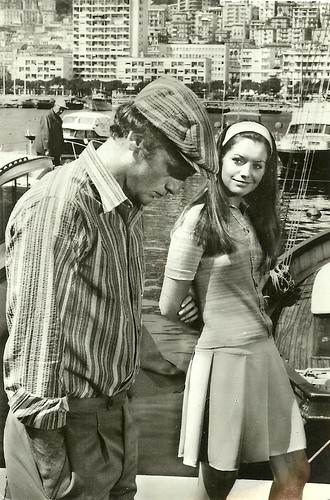
Romanian postcard by Casa Filmului Acin, no. 105. Catherine Spaak and Philippe Leroy in La notte è fatta per... rubare/Night Is Made for Stealing (Giorgio Capitani, 1968), which evolves in Montecarlo.
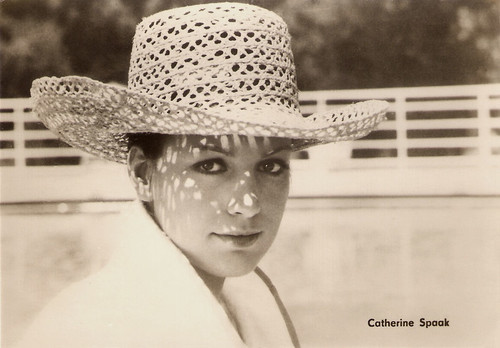
East-German postcard by VEB Progress Film-Vertrieb, Berlin, no. 24/69, 1969. Retail price: 0,20 DM. Photo: Catherine Spaak in La notte è fatta per... rubare /Night Is Made for Stealing (Giorgio Capitani, 1968).
The Cat of Nine Tails
Seeking a new direction, Catherine Spaak joined fellow singer Johnny Dorelli in the operetta 'La vedova allegra' (The Merry Widow) in 1968. The pair went on to enjoy a lasting relationship, both personally and professionally. They enjoyed success as a duo with 'Song sung blue' (1972) and 'Una serata insieme a te' (1973).
During the early 1970s, she continued to appear in many Italian films, but they became less interesting. She starred with Karl Malden and James Franciscus in the Giallo Il gatto a nove code/The Cat o' Nine Tails (Dario Argento, 1971). A reviewer at IMDb calls it "An entertaining and clever thriller that's well worth a look."
In France she made the crime film Un meurtre est un meurtre/A Murder Is a Murder... Is a Murder (Étienne Périer, 1972) with Jean-Claude Brialy . In the American-Italian Western Take a Hard Ride (Antonio Margheriti, 1975), she co-starred with Jim Brown and Lee van Cleef.
From then on, her film appearances became more incidental. In 1978, she had success on stage in the musical 'Cyrano', and would continue to play on stage. She hosted several Italian TV shows such as Forum (1985-1988) and Harem (1989-2002) and wrote articles for the newspaper Il corriere della sera and Italian magazines. She also published six books in Italian, such as '26 Donne' (26 women, 1984), 'Un cuore perso' (A lost heart, 1996), 'Lui' (He, 2006) and 'L’amore blu'(Blue Love, 2011).
Her later films include the sex comedy anthology Sunday Lovers (Bryan Forbes, Edouard Molinaro, Dino Risi, Gene Wilder, 1980) as Ugo Tognazzi ’s psychoanalyst, Scandalo Segreto/Secret Scandal (Monica Vitti, 1989) and Tandem (Lucio Pellegrini, 2000) starring the comic duo Luca & Paolo.
More recently she was seen in the film Alice (Oreste Crisostomi, 2009), the BBC mini-series Zen (John Alexander, Jon Jones, Christopher Menaul, 2011) starring Rufus Sewell as detective Aurelio Zen and Spaak as his Mamma, and the film I più' grandi di tutti/The greatest of all (Carlo Virzì, 2012).
Catherine Spaak was married to actor and producer Fabrizio Capucci (1963-1971) and Italian singer-actor Johnny Dorelli (1972-1979). Her last husband was actor Orso Maria Guerrini. With Capucci, she had a daughter, stage actress Sabrina Capucci (1963), and with Dorelli a son, Gabriele Dorelli. Spaak died in 2022 at the age of 77, having previously suffered two brain hemorrhages.
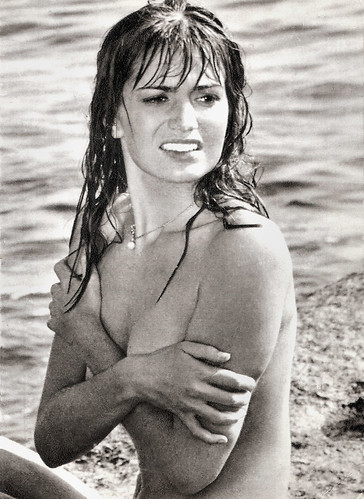
Italian collectors card by La Rotografica Romana. Edito dalla Nat Nuova Alta Tensione.
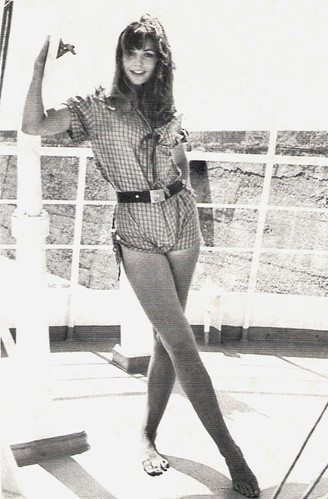
Romanian postcard by Casa Filmului Acin.
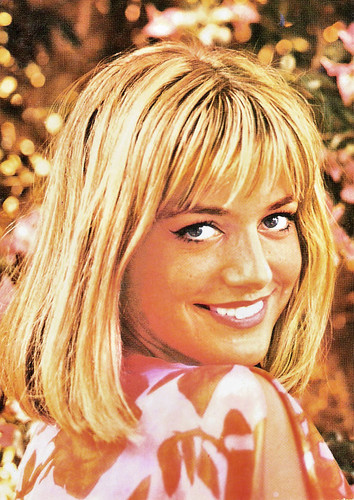
Romanian postcard by Casa Filmului Acin.

Romanian postcard by Casa Filmului Acin.
Sources: Hal Erickson (AllMovie), CatherineSpaak.eu, Ready Steady Girls!, Wikipedia (Italian, French, German and English) and .

Italian postcard by Rotalfoto (Rotalcolor), Milano, no. 244.

Romanian postcard by Casa Filmului Acin, no. 519.

Romanian postcard by Casa Filmului Acin, no. 91.
The niece of the Belgian prime minister
Catherine Spaak was born in Boulogne-Billancourt, France in 1945. Her father was the Belgian critic and screenwriter Charles Spaak, her mother the actress Claudie Clèves and her sister is actress-photographer Agnès Spaak.
As a teenager, Catherine started her career with small roles in French films like the short L’hiver/The winter (Jacques Gautier, 1959) and the thriller Le Trou/Nightwatch (Jacques Becker, 1960).
When she moved to Italy later that year, her father introduced her to film director Alberto Lattuada, who cast her in his film I dolci inganni/Sweet Deceptions (Alberto Lattuada, 1960). That coming of age film made her a star in Italy. She played a young Roman girl in love, who spends the day observing other lovers' behaviours and considering whether she is ready to jump.
J.C. Mohsen at IMDb : “This film's unpredictability is refreshing. Whether written or filmed, coming-of-age stories often fail to surprise or intrigue the audience. In I Dolci Inganni, most characters seem at first to be crazily entertaining walking clichés, but they later astonish the audience by revealing their depth and their inner struggles.”
From age 15 to 18, Spaak was the lead actress in a dozen films, including La voglia matta/Crazy Desire (Luciano Salce, 1961) opposite Ugo Tognazzi , the classic comedy Il sorpasso/The Easy Life (Dino Risi, 1962) with Vittorio Gassman , La parmigiana/The Girl from Parma (Antonio Pietrangeli, 1963) with Nino Manfredi , and the Alberto Moravia adaptation La noia/The Empty Canvas (Damiano Damiani, 1963) with Horst Buchholz and Bette Davis .
For her performance in La noia she was awarded the David di Donatello, the Italian Oscar, in 1964. Spaak often played the Lolita-type who seduced men, and the Italian scandal press wrote about herself in that way. In their articles, journalists always included that she was the niece of the Belgian prime minister, Paul-Henri Spaak.

Italian postcard by Rotalfoto, Milano, no. 194.

Small Romanian collectors card. Photo: Catherine Spaak in Made in Italy (Nanni Loy, 1965).

Italian postcard by Edizione diesse.
Highlights of the Commedia all'Italiana
Catherine Spaak’s screen success, combined with her love of singing and guitar playing, led to an offer from the Ricordi label in 1962. She recorded covers of Françoise Hardy's originals and songs in Hardy’s style.
Ready steady girls! , the site on Europe’s fab female singers of the 1960s in their bio: “Perdono – written by Gino Paoli (who had worked with stars such as Mina ) and arranged by Ennio Morricone – was issued as her debut single and swiftly made the Italian top 20.
Vocally, Catherine drew comparisons with France’s newest star, Françoise Hardy , so Ricordi opted to have their young signing record a couple of Hardy songs for the Italian market. Issued in 1963, the bilingual 'Tous les garçons et les filles' (Quelli della mia età) – backed with J’ai jeté mon coeur (Ho scherzato con il cuore) – gave Hardy’s original a run for its money, reaching number seven in September 1963 and confirming Catherine as a new star.”
In 1964, she returned to France to appear in La Ronde (Roger Vadim, 1964) and the war drama Week-end à Zuydcoote/Weekend at Dunkirk (Henri Verneuil, 1964) starring Jean-Paul Belmondo .
Back in Italy she played in some more highlights of the Commedia all'Italiana such as L'armata Brancaleone/Brancaleone's Army (Mario Monicelli, 1965) featuring Vittorio Gassman , and Made in Italy (Nanni Loy, 1965).
Other notable appearances include L'uomo dei cinque palloni/Break up (Marco Ferreri, 1965) starring Marcello Mastroianni , and La matriarca/The Libertine (Pasquale Festa Campanile, 1968) with Jean-Louis Trintignant .
In 1967 she went to Hollywood to play Rod Taylor’s love interest in Hotel (Richard Quine, 1967), based on the novel by Arthur Hailey. Hal Erickson at AllMovie : “Once she came to Hollywood, however, Spaak was packaged and promoted as just another foreign starlet, interchangeable with Claudia Cardinale , Camilla Sparv, Elke Sommer and the rest of the batch.”
The result was not a success and soon she was back in Italy. Two years later she did a cameo in another Hollywood production, If It's Tuesday, This Must Be Belgium (Mel Stuart, 1969).

Romanian postcard by Casa Filmului Acin, no. 25. Photo: Catherine Spaak and Philippe Leroy in the crime comedy La notte è fatta per... rubare/Night Is Made for Stealing (Giorgio Capitani, 1968).

Romanian postcard by Casa Filmului Acin, no. 105. Catherine Spaak and Philippe Leroy in La notte è fatta per... rubare/Night Is Made for Stealing (Giorgio Capitani, 1968), which evolves in Montecarlo.

East-German postcard by VEB Progress Film-Vertrieb, Berlin, no. 24/69, 1969. Retail price: 0,20 DM. Photo: Catherine Spaak in La notte è fatta per... rubare /Night Is Made for Stealing (Giorgio Capitani, 1968).
The Cat of Nine Tails
Seeking a new direction, Catherine Spaak joined fellow singer Johnny Dorelli in the operetta 'La vedova allegra' (The Merry Widow) in 1968. The pair went on to enjoy a lasting relationship, both personally and professionally. They enjoyed success as a duo with 'Song sung blue' (1972) and 'Una serata insieme a te' (1973).
During the early 1970s, she continued to appear in many Italian films, but they became less interesting. She starred with Karl Malden and James Franciscus in the Giallo Il gatto a nove code/The Cat o' Nine Tails (Dario Argento, 1971). A reviewer at IMDb calls it "An entertaining and clever thriller that's well worth a look."
In France she made the crime film Un meurtre est un meurtre/A Murder Is a Murder... Is a Murder (Étienne Périer, 1972) with Jean-Claude Brialy . In the American-Italian Western Take a Hard Ride (Antonio Margheriti, 1975), she co-starred with Jim Brown and Lee van Cleef.
From then on, her film appearances became more incidental. In 1978, she had success on stage in the musical 'Cyrano', and would continue to play on stage. She hosted several Italian TV shows such as Forum (1985-1988) and Harem (1989-2002) and wrote articles for the newspaper Il corriere della sera and Italian magazines. She also published six books in Italian, such as '26 Donne' (26 women, 1984), 'Un cuore perso' (A lost heart, 1996), 'Lui' (He, 2006) and 'L’amore blu'(Blue Love, 2011).
Her later films include the sex comedy anthology Sunday Lovers (Bryan Forbes, Edouard Molinaro, Dino Risi, Gene Wilder, 1980) as Ugo Tognazzi ’s psychoanalyst, Scandalo Segreto/Secret Scandal (Monica Vitti, 1989) and Tandem (Lucio Pellegrini, 2000) starring the comic duo Luca & Paolo.
More recently she was seen in the film Alice (Oreste Crisostomi, 2009), the BBC mini-series Zen (John Alexander, Jon Jones, Christopher Menaul, 2011) starring Rufus Sewell as detective Aurelio Zen and Spaak as his Mamma, and the film I più' grandi di tutti/The greatest of all (Carlo Virzì, 2012).
Catherine Spaak was married to actor and producer Fabrizio Capucci (1963-1971) and Italian singer-actor Johnny Dorelli (1972-1979). Her last husband was actor Orso Maria Guerrini. With Capucci, she had a daughter, stage actress Sabrina Capucci (1963), and with Dorelli a son, Gabriele Dorelli. Spaak died in 2022 at the age of 77, having previously suffered two brain hemorrhages.

Italian collectors card by La Rotografica Romana. Edito dalla Nat Nuova Alta Tensione.

Romanian postcard by Casa Filmului Acin.

Romanian postcard by Casa Filmului Acin.

Romanian postcard by Casa Filmului Acin.
Sources: Hal Erickson (AllMovie), CatherineSpaak.eu, Ready Steady Girls!, Wikipedia (Italian, French, German and English) and .
Published on April 18, 2022 22:00
April 17, 2022
VerzamelJaarbeurs 2022: Ivo’s treasures
On Saturday 9 and Sunday 10 April 2022, we could finally attend the VerzamelJaarbeurs again. The Jaarbeurs halls in the city of Utrecht were transformed into the largest collectors' fair in Europe. You can find pretty much everything you can collect, from vintage furniture, a huge collection of vinyl, toys from the past and present, games, stamps, and lots of other beautiful curiosities and articles. Marlene, Ivo, and I were there to look for interesting film postcards for EFSP. Last Monday, we presented the treasures I discovered in Utrecht. Today's it's Ivo Blom's turn.
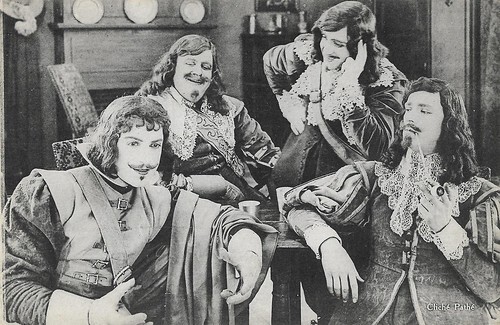
French postcard. Photo: Pathé. Left to right: Aimé Simon-Girard as D'Artagnan, Charles Martinelli as Porthos, Pierre de Guingand as Aramis, and Henri Rollan as Athos in Les trois mousquetaires/The Three Musketeers (Henri Diamant-Berger, 1921). This card is part of six cards of this film we recently found at the Utrecht collectors' fair. These are additional to the ones we already uploaded. The others will be uploaded soon.
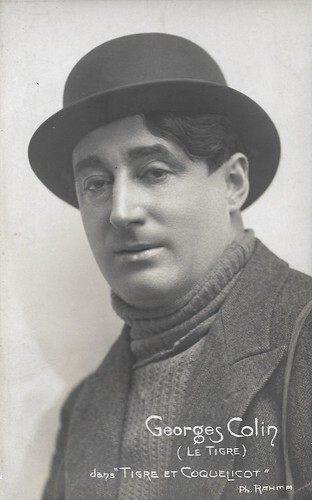
French postcard. Photo: Rahma. Georges Colin as Le Tigre in the play 'Le Tigre et Coquelicot' by Charles Henry Hirsch, staged in 1923 at the Théâtre Cora Laparcerie in Paris. Laparcerie played the female lead opposite Colin.
Georges Colin (1880-1945) was a French actor, who appeared in nearly 40 silent and sound films between 1909 and 1945.
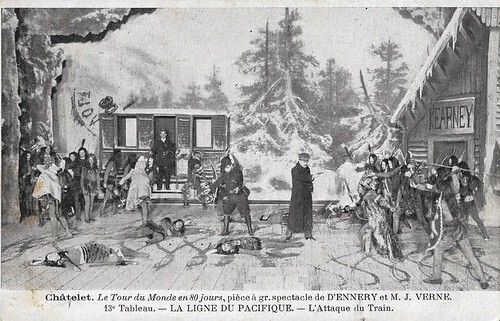
French postcard by Théâtre du Chatelet. Photo: scene from the play 'La Tour du Monde en 80 jours' (Around the world in eighty days). Caption: Pièce à grand spectacle de D'Ennery et monsieur Jules Verne. 13e Tableau, La Ligne du Pacifique. L'Attaque du Train. (A large-scale play by D'Ennery and Monsieur Jules Verne. 13th act, The Pacific Line. The Attack on the Train.)
The play 'La Tour du Monde en 80 jours' (Around the world in eighty days) was written by Adolphe D'Ennery and Jules Verne, after Verne's eponymous novel, written in 1873-1874. It was first performed 7 November 1874 at the Théâtre de la Porte-Saint-Martin in Paris. Despite the enormous investments, even a real elephant was involved, the play was a giant success. People were queuing around the block to see how one could travel the whole world in eighty days, and in the case of the play, within the time span of just a few hours. From 1874 to the start of WWII, the play was constantly restaged and with great success. The version of this card must date from the early 1900s, while the first staging at the Châtelet dates of 1887, where it remained a crowd-puller for years. On 19 June, EFSP will present a special post on the French author, 'Written by Jules Verne'.
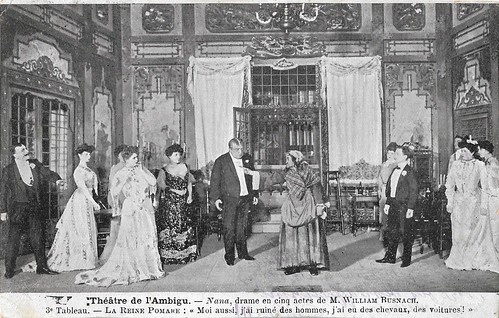
French postcard. Scene from the play 'Nanà' by William Busnach, a play in five acts adapted from the novel by Emile Zola and performed at the Théâtre de l'Ambigu. Tableau 3, Queen Pomare: I too ruined men, owned horses and carriages. The play was first performed at the Théâtre de l'Ambigu on 6 February 1904. Nanâ was played by Armande Cassive. It was one of her most memorable roles.
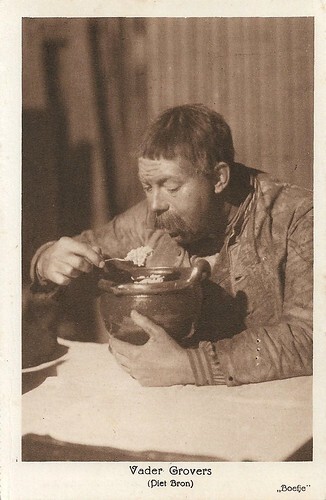
Dutch postcard by Vereenigd Rotterdamsch Hofstadtooneel, part of a booklet on the stage play 'Boefje'. Photo: Willem Coret, The Hague. Piet Bron as father Grovers in the stage play 'Boefje' (Little Rascal, 1922), starring Annie van Ees, who also played the lead in the 1939 Dutch film adaptation by Douglas Sirk. The play was staged by Van Ees' husband, Cor van der Lugt Melsert and was immensely popular.
Dutch stage and screen actor Piet Bron (1882-1973) was especially known for his father role in the play 'Boefje', adapted from the 1905 novel by M.J. Brusse. Bron played the part 550 times. Bron also acted in the film. He had one of the leads in the film adaptation of Merijntje Gijzen's jeugd (1936), based on the novel by A.M. de Jong, and directed by German emigré Kurt Gerron.
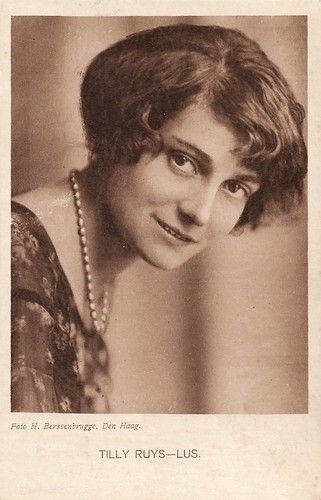
Dutch postcard in the Photogravure series b, no. 903. Photo: Henri Berssenbrugge, The Hague. This sepia card is part of a large series of 1920s Dutch stage players and directors, photographed by Berssenbrugge and other acclaimed Dutch photographers such as J. Merkelbach.
Tilly Lus (1888-1971) was a Dutch theatre actress. She also played a handful of parts in Dutch silent cinema between 1911 and 1915. She debuted as a supporting actress in the film De Bannelingen/The Exiles (Leon Boedels, Caroline van Dommelen, 1911), produced by Film-Fabriek F.A. Nöggerath. In 1912 Lus started to act also at the new film company Hollandia. In 1915, she married Cor Ruys, actor and theatre manager, with whom she had six children.
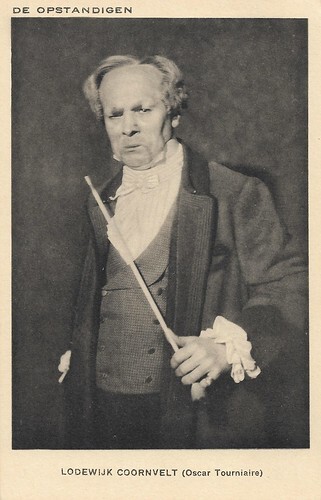
Dutch postcard. Part of a booklet of cards for the Dutch stage play 'De Opstandigen' (The Rebels) by August Defresne and based on the novel by Jo van Ammers-Küller. It premiered on 6 November 1926 at the Hollandsche Schouwburg in Amsterdam and was performed by the company Het Nieuwe Nederlandsch Tooneel. The Director and art director of the play was Louis Saalborn.
Oscar Tourniaire had the male lead as the stern patriarch Lodewijk Coornvelt, while the female lead was for Jacqueline Royaards-Sandberg as Maria Elizabeth "Miebetje" Sylvain, the only one to resist the patriarch's autocratic, conservative rule. Oscar Tourniaire (1880-1939) was a major Dutch stage actor. In 1898 he made his stage debut with the Koninklijke Vereeniging Het Nederlandsch Tooneel (K.V.H.N.T.). Tourniaire directed one silent film for Film-Fabriek Anton Nöggerath, Roze Kate/Pink Kate (1912).
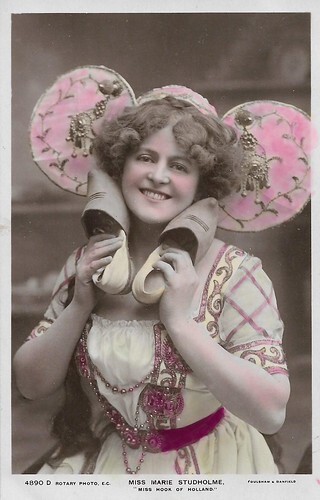
British postcard by Rotary Photo, E.C., no. 4890 D. Photo: Foulsham and Banfield. Marie Studholme in the musical comedy 'Miss Hook of Holland' (1907) by Paul Rubens. She starred in the title role, during a long provincial tour from 1907 to 1910, while originally in London, Isabel Jay played the lead in the same play.
Marie Studholme (1872-1930) was an English actress and singer of the Victorian and Edwardian eras, known for her supporting and sometimes starring roles in Edwardian musical comedy. Her attractive features (and outfits) made her one of the most popular postcard beauties of her day. The masses of postcards of her today still testify to this popularity. As far as we know, she never played in the cinema.
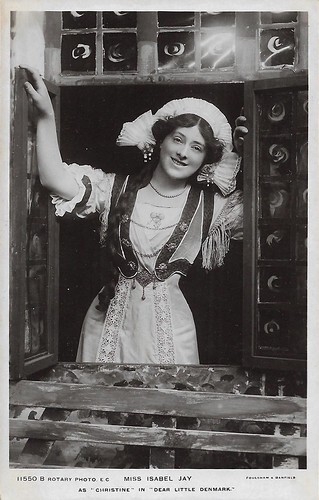
British postcard by Rotary Photo, E.C., no. 11550 B. Photo: Foulsham and Banfield. In 1909 Isabel Jay starred in the musical comedy 'Dear Little Denmark', written by Paul Rubens. It was felt to be too much of a repetition of Rubens' extremely popular operetta 'Miss Hook of Holland' (1907), in which Jay had starred before, earlier in 1907.
Isabel Jay (11879-1927) was an English opera singer and actress, best known for her performances in soprano roles of the Savoy Operas with the D'Oyly Carte Opera Company and in Edwardian musical comedies. During Jay's career, picture postcards were immensely popular, and Jay was photographed for over 400 different postcards. She retired in 1911 at age 31. As far as we know, she didn't act in the film.
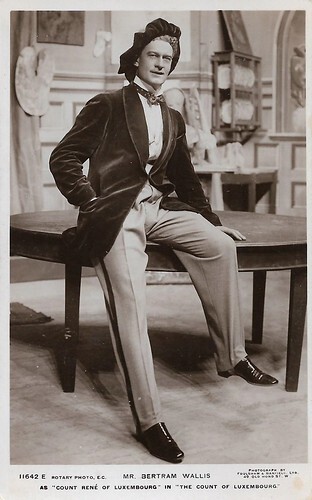
British postcard by Rotary Photo, E.C., no. 11642 E. Photo: Foulsham and Banfield. Bertram Wallis in 'The Count of Luxembourg', an operetta in two acts with English lyrics and libretto by Basil Hood and Adrian Ross, music by Franz Lehár, based on Lehár's three-act German operetta 'Der Graf von Luxemburg' which had premiered in Vienna in 1909. The original production opened at Daly's Theatre in London in 1911 and ran for 345 performances, starring Lily Elsie, Huntley Wright, W. H. Berry, and Bertram Wallis.
Tall and handsome Bertram Wallis (1874-1952) was a renowned English actor and singer. He was a glamorous matinée idol in popular plays and musical comedies in the early 20th century. Between the two wars, he also appeared in several films.
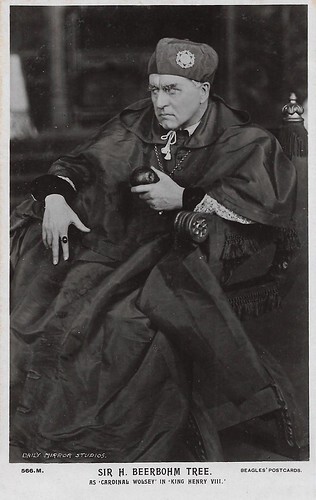
British postcard by Beagles' postcards, no. 566 M. Photo: Daily Mirror Studios. Sir Herbert Beerbohm Tree as Cardinal Wolsey in the play 'Henry VIII', Tree's longest-running revival. It ran for a sensational 254 consecutive performances from 1 September 1910 to 8 April 1911.
Sir Herbert Beerbohm Tree (1852-1917) was one of the most famous English actors and theatre managers of the late Victorian and early Edwardian periods. In 1895 he put on the first production of 'A Woman of No Importance', a new play written by Oscar Wilde. Beerbohm Tree also helped the career of George Bernard Shaw, by producing 'Pygmalion' in 1914. His lavish productions with their strong emphasis on the visual can be seen as prefiguring the cinema. The versatile and skilled actor also appeared in some early British and American films. He founded the Royal Academy of Dramatic Art in 1904 and was knighted, for his contributions to the theatre, in 1909. Famous film director Carol Reed was one of his illegitimate children and actor Oliver Reed was a grandson.
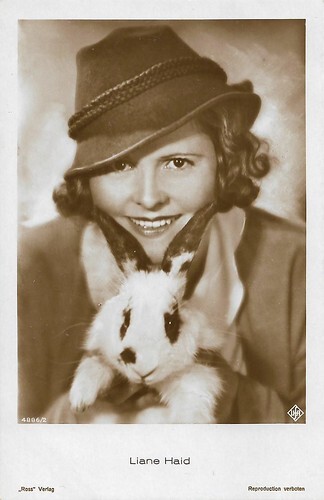
German postcard by Ross Verlag, no. 4886/2, 1929-1930. Photo: Ufa.
Prima ballerina, dancer, singer, and actress Liane Haid (1895-2000) was the first film star of Austria. She was the epitome of the 'Süßes Wiener Mädel' (Sweet Viennese Girl) and from the mid-1910s on she made close to a hundred films.
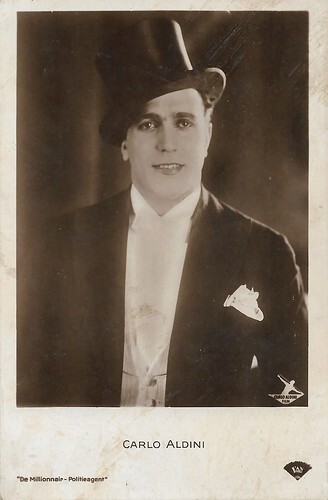
Dutch postcard by FAN Film. Photo: Carlo Aldini Film. Carlo Aldini in Der Mann ohne Kopf (Nunzio Malasomma, 1927). Dutch distributor FAN Film released the film as 'De Millionnair-Politieagent'. The back of the card makes publicity for the film at the Flora Theatre in The Hague, where the film was shown in March 1929. The film started its Dutch release in January 1929 at the Amsterdam based Passage-Bioscoop.
Carlo Aldini (1894-1961) was an athletic hero of the Italian and German silent cinema. In Der Mann ohne Kopf, Aldini plays a double role: millionaire Freddy Hillock, who has serious brain damage after a flight accident, trades places with poor police officer John, after a night of merriment and booze. For both the change has serious consequences: John has to train for many sports like wrestling and polo, under the severe guidance of a robust black trainer. Freddy becomes police officer. After causing mishap because of his confused brain, he has to save his girlfriend and after wild chases he manages, regaining his wits as bonus. The Bundesarchiv Berlin has a print of he film.
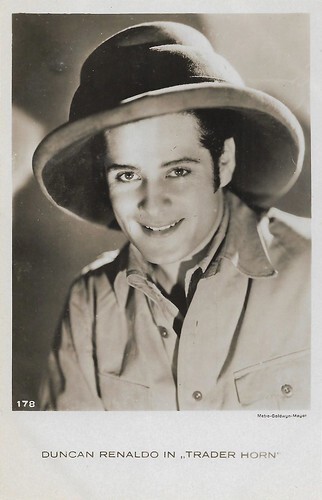
Dutch postcard, no. 178. Photo: Metro-Goldwyn-Mayer. Duncan Renaldo in Trader Horn (W.S. Van Dyke, 1931).
Renault Renaldo Duncan (1904–1980), better known as Duncan Renaldo, was a Romanian-born American actor best remembered for his portrayal of The Cisco Kid in films and on the 1950-1956 American TV series, The Cisco Kid.

West-German postcard by Kunst und Bild.
Sophia Loren (1934) rose to fame in post-war Italy as a voluptuous sex goddess. Soon after, she became one of the most successful stars of the 20th Century, who won an Oscar for her mother role in La ciociara (Vittorio De Sica, 1960).

French postcard. Photo: Pathé. Left to right: Aimé Simon-Girard as D'Artagnan, Charles Martinelli as Porthos, Pierre de Guingand as Aramis, and Henri Rollan as Athos in Les trois mousquetaires/The Three Musketeers (Henri Diamant-Berger, 1921). This card is part of six cards of this film we recently found at the Utrecht collectors' fair. These are additional to the ones we already uploaded. The others will be uploaded soon.

French postcard. Photo: Rahma. Georges Colin as Le Tigre in the play 'Le Tigre et Coquelicot' by Charles Henry Hirsch, staged in 1923 at the Théâtre Cora Laparcerie in Paris. Laparcerie played the female lead opposite Colin.
Georges Colin (1880-1945) was a French actor, who appeared in nearly 40 silent and sound films between 1909 and 1945.

French postcard by Théâtre du Chatelet. Photo: scene from the play 'La Tour du Monde en 80 jours' (Around the world in eighty days). Caption: Pièce à grand spectacle de D'Ennery et monsieur Jules Verne. 13e Tableau, La Ligne du Pacifique. L'Attaque du Train. (A large-scale play by D'Ennery and Monsieur Jules Verne. 13th act, The Pacific Line. The Attack on the Train.)
The play 'La Tour du Monde en 80 jours' (Around the world in eighty days) was written by Adolphe D'Ennery and Jules Verne, after Verne's eponymous novel, written in 1873-1874. It was first performed 7 November 1874 at the Théâtre de la Porte-Saint-Martin in Paris. Despite the enormous investments, even a real elephant was involved, the play was a giant success. People were queuing around the block to see how one could travel the whole world in eighty days, and in the case of the play, within the time span of just a few hours. From 1874 to the start of WWII, the play was constantly restaged and with great success. The version of this card must date from the early 1900s, while the first staging at the Châtelet dates of 1887, where it remained a crowd-puller for years. On 19 June, EFSP will present a special post on the French author, 'Written by Jules Verne'.

French postcard. Scene from the play 'Nanà' by William Busnach, a play in five acts adapted from the novel by Emile Zola and performed at the Théâtre de l'Ambigu. Tableau 3, Queen Pomare: I too ruined men, owned horses and carriages. The play was first performed at the Théâtre de l'Ambigu on 6 February 1904. Nanâ was played by Armande Cassive. It was one of her most memorable roles.

Dutch postcard by Vereenigd Rotterdamsch Hofstadtooneel, part of a booklet on the stage play 'Boefje'. Photo: Willem Coret, The Hague. Piet Bron as father Grovers in the stage play 'Boefje' (Little Rascal, 1922), starring Annie van Ees, who also played the lead in the 1939 Dutch film adaptation by Douglas Sirk. The play was staged by Van Ees' husband, Cor van der Lugt Melsert and was immensely popular.
Dutch stage and screen actor Piet Bron (1882-1973) was especially known for his father role in the play 'Boefje', adapted from the 1905 novel by M.J. Brusse. Bron played the part 550 times. Bron also acted in the film. He had one of the leads in the film adaptation of Merijntje Gijzen's jeugd (1936), based on the novel by A.M. de Jong, and directed by German emigré Kurt Gerron.

Dutch postcard in the Photogravure series b, no. 903. Photo: Henri Berssenbrugge, The Hague. This sepia card is part of a large series of 1920s Dutch stage players and directors, photographed by Berssenbrugge and other acclaimed Dutch photographers such as J. Merkelbach.
Tilly Lus (1888-1971) was a Dutch theatre actress. She also played a handful of parts in Dutch silent cinema between 1911 and 1915. She debuted as a supporting actress in the film De Bannelingen/The Exiles (Leon Boedels, Caroline van Dommelen, 1911), produced by Film-Fabriek F.A. Nöggerath. In 1912 Lus started to act also at the new film company Hollandia. In 1915, she married Cor Ruys, actor and theatre manager, with whom she had six children.

Dutch postcard. Part of a booklet of cards for the Dutch stage play 'De Opstandigen' (The Rebels) by August Defresne and based on the novel by Jo van Ammers-Küller. It premiered on 6 November 1926 at the Hollandsche Schouwburg in Amsterdam and was performed by the company Het Nieuwe Nederlandsch Tooneel. The Director and art director of the play was Louis Saalborn.
Oscar Tourniaire had the male lead as the stern patriarch Lodewijk Coornvelt, while the female lead was for Jacqueline Royaards-Sandberg as Maria Elizabeth "Miebetje" Sylvain, the only one to resist the patriarch's autocratic, conservative rule. Oscar Tourniaire (1880-1939) was a major Dutch stage actor. In 1898 he made his stage debut with the Koninklijke Vereeniging Het Nederlandsch Tooneel (K.V.H.N.T.). Tourniaire directed one silent film for Film-Fabriek Anton Nöggerath, Roze Kate/Pink Kate (1912).

British postcard by Rotary Photo, E.C., no. 4890 D. Photo: Foulsham and Banfield. Marie Studholme in the musical comedy 'Miss Hook of Holland' (1907) by Paul Rubens. She starred in the title role, during a long provincial tour from 1907 to 1910, while originally in London, Isabel Jay played the lead in the same play.
Marie Studholme (1872-1930) was an English actress and singer of the Victorian and Edwardian eras, known for her supporting and sometimes starring roles in Edwardian musical comedy. Her attractive features (and outfits) made her one of the most popular postcard beauties of her day. The masses of postcards of her today still testify to this popularity. As far as we know, she never played in the cinema.

British postcard by Rotary Photo, E.C., no. 11550 B. Photo: Foulsham and Banfield. In 1909 Isabel Jay starred in the musical comedy 'Dear Little Denmark', written by Paul Rubens. It was felt to be too much of a repetition of Rubens' extremely popular operetta 'Miss Hook of Holland' (1907), in which Jay had starred before, earlier in 1907.
Isabel Jay (11879-1927) was an English opera singer and actress, best known for her performances in soprano roles of the Savoy Operas with the D'Oyly Carte Opera Company and in Edwardian musical comedies. During Jay's career, picture postcards were immensely popular, and Jay was photographed for over 400 different postcards. She retired in 1911 at age 31. As far as we know, she didn't act in the film.

British postcard by Rotary Photo, E.C., no. 11642 E. Photo: Foulsham and Banfield. Bertram Wallis in 'The Count of Luxembourg', an operetta in two acts with English lyrics and libretto by Basil Hood and Adrian Ross, music by Franz Lehár, based on Lehár's three-act German operetta 'Der Graf von Luxemburg' which had premiered in Vienna in 1909. The original production opened at Daly's Theatre in London in 1911 and ran for 345 performances, starring Lily Elsie, Huntley Wright, W. H. Berry, and Bertram Wallis.
Tall and handsome Bertram Wallis (1874-1952) was a renowned English actor and singer. He was a glamorous matinée idol in popular plays and musical comedies in the early 20th century. Between the two wars, he also appeared in several films.

British postcard by Beagles' postcards, no. 566 M. Photo: Daily Mirror Studios. Sir Herbert Beerbohm Tree as Cardinal Wolsey in the play 'Henry VIII', Tree's longest-running revival. It ran for a sensational 254 consecutive performances from 1 September 1910 to 8 April 1911.
Sir Herbert Beerbohm Tree (1852-1917) was one of the most famous English actors and theatre managers of the late Victorian and early Edwardian periods. In 1895 he put on the first production of 'A Woman of No Importance', a new play written by Oscar Wilde. Beerbohm Tree also helped the career of George Bernard Shaw, by producing 'Pygmalion' in 1914. His lavish productions with their strong emphasis on the visual can be seen as prefiguring the cinema. The versatile and skilled actor also appeared in some early British and American films. He founded the Royal Academy of Dramatic Art in 1904 and was knighted, for his contributions to the theatre, in 1909. Famous film director Carol Reed was one of his illegitimate children and actor Oliver Reed was a grandson.

German postcard by Ross Verlag, no. 4886/2, 1929-1930. Photo: Ufa.
Prima ballerina, dancer, singer, and actress Liane Haid (1895-2000) was the first film star of Austria. She was the epitome of the 'Süßes Wiener Mädel' (Sweet Viennese Girl) and from the mid-1910s on she made close to a hundred films.

Dutch postcard by FAN Film. Photo: Carlo Aldini Film. Carlo Aldini in Der Mann ohne Kopf (Nunzio Malasomma, 1927). Dutch distributor FAN Film released the film as 'De Millionnair-Politieagent'. The back of the card makes publicity for the film at the Flora Theatre in The Hague, where the film was shown in March 1929. The film started its Dutch release in January 1929 at the Amsterdam based Passage-Bioscoop.
Carlo Aldini (1894-1961) was an athletic hero of the Italian and German silent cinema. In Der Mann ohne Kopf, Aldini plays a double role: millionaire Freddy Hillock, who has serious brain damage after a flight accident, trades places with poor police officer John, after a night of merriment and booze. For both the change has serious consequences: John has to train for many sports like wrestling and polo, under the severe guidance of a robust black trainer. Freddy becomes police officer. After causing mishap because of his confused brain, he has to save his girlfriend and after wild chases he manages, regaining his wits as bonus. The Bundesarchiv Berlin has a print of he film.

Dutch postcard, no. 178. Photo: Metro-Goldwyn-Mayer. Duncan Renaldo in Trader Horn (W.S. Van Dyke, 1931).
Renault Renaldo Duncan (1904–1980), better known as Duncan Renaldo, was a Romanian-born American actor best remembered for his portrayal of The Cisco Kid in films and on the 1950-1956 American TV series, The Cisco Kid.

West-German postcard by Kunst und Bild.
Sophia Loren (1934) rose to fame in post-war Italy as a voluptuous sex goddess. Soon after, she became one of the most successful stars of the 20th Century, who won an Oscar for her mother role in La ciociara (Vittorio De Sica, 1960).
Published on April 17, 2022 22:00
April 15, 2022
Boomerang Freecards
With rented tricycles full of map racks, the founders of Boomerang strolled along the cafés in Amsterdam and the other Dutch cities. "It was the spring of 1993. Everyone wanted such a rack on their wall", they remember on their website. Boomerang introduced freecards. "Our idea at the time was that advertising should be so nice that people would come and get it themselves from our racks." In the past three decades, Boomerang has grown into a cultural phenomenon and has evolved into an international media conglomerate. Boomerang gave the film postcard a new impulse. Here are 16 great examples of their film freecards.
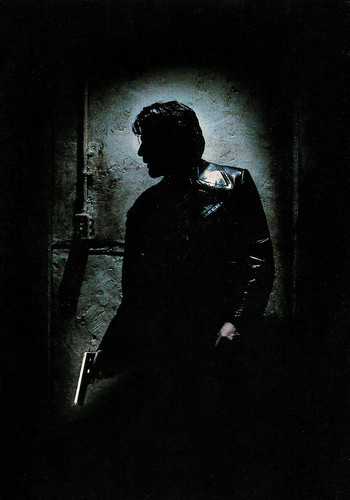
Dutch postcard by Boomerang, Amsterdam. Photo: Al Pacino in Carlito's Way (Brian De Palma, 1993).
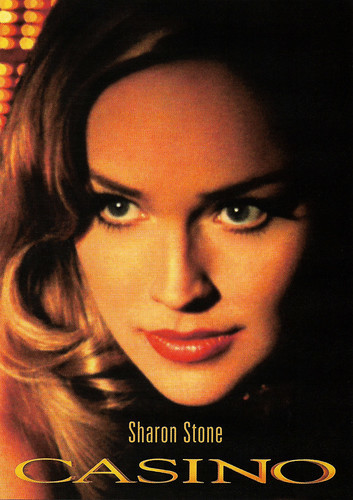
Dutch postcard by Boomerang Freecards, Amsterdam. Photo: Sharon Stone in Casino (Martin Scorsese, 1995).
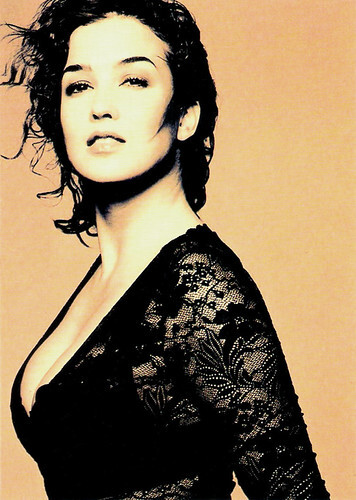
Dutch postcard by Boomerang, no. P18-06. Photo: Frans Jansen / BNN. Sexy and exotic Katja Schuurman (1975) was one of the first soap stars of the Netherlands. She showed durability as a TV host and as an actress in many TV series and films.
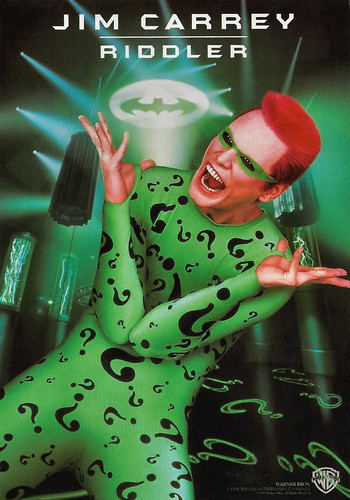
Belgian postcard by Boomerang Free Cards. Photo: Warner Bros. Jim Carrey as Riddler in Batman Forever (Joel Schumacher, 1995).
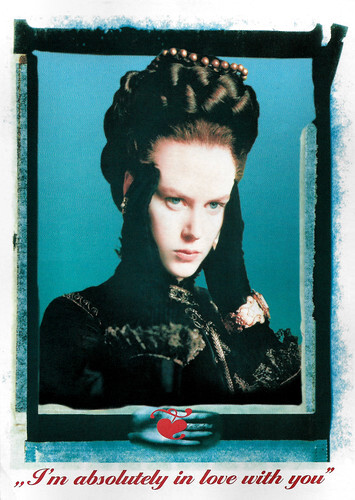
Dutch postcard by Boomerang Freecards, Amsterdam. Nicole Kidman in The Portrait of a Lady (Jane Campion, 1996). Captions: I'm absolutely in love with you (front). After 'The Piano' the new film by Jane Campion.
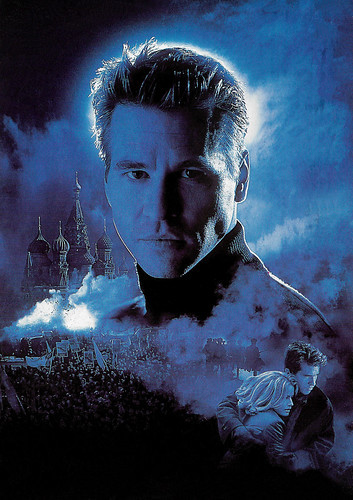
British postcard by Boomerang Media. Photo: Paramount. Val Kilmer in The Saint (Philip Noyce, 1997).
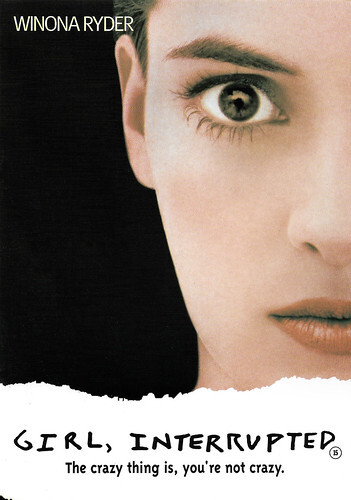
British freecard by Boomerang. Winona Ryder in Girl, Interrupted (James Mangold, 1999). Captions: The crazy thing is, you're not crazy. Girl, Interrupted. Based on a true story. Opens March 24 at Cinemas across the country.
The Freecards phenomenon
Freecards are free postcards that are distributed in different ways. Some publishers distribute the cards via their own racks, which are hung up in hotels, restaurants, schools, gyms and/or on golf courses. Other publishers offer the cards through bookstores, cinemas, at events, or in (their own) shops.
The first publisher of freecards was Vanguardia in Spain in 1985. France followed in 1987, Italy in 1989, Denmark in 1990, Belgium and Sweden in 1991, Germany, Switzerland, Australia, Canada and the United Kingdom in 1992, and the Netherlands and several other countries in 1993.
In the Netherlands, the freecards were initially published by Free Card and Take Art. But Boomerang took over, quickly followed by competitor Advertising Post.
The VDP (Vereniging Documentatie Prentbriefkaarten) has been busy from the beginning with documenting the released freecards in the Netherlands. In September 1994 the very first VDP freecard catalogue was published, containing all the Boomerang and Advertising Post cards released at that time. Since then the VDP and since 2003 the Boomerang Fanclub (BFC) releases a new freecard catalogue every year.
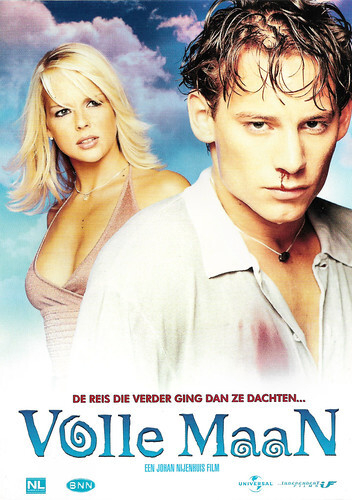
Dutch postcard by Boomerang, Amsterdam. Photo: Ray Christian / De Krom Studio. Artwork: Michiel van Randeraat / Locust Enterainment. Cas Jansen and Chantal Janzen in Volle Maan/Full Moon Party (Johan Nijenhuis, 2002).

British postcard by Boomerang Media Cards in the Best of British Quirky Traits series, no. 6, Humour. Photo: Jon Lyons. Tommy Cooper. Collection: Carla Bosch.
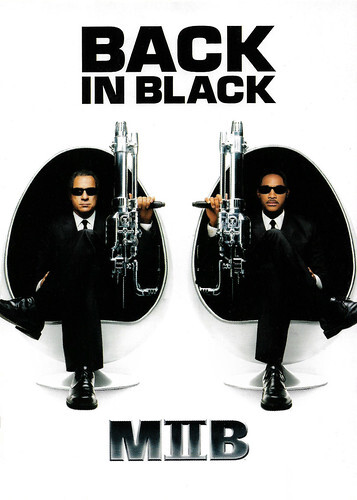
Dutch postcard by Boomerang. Photo: Amblin Entertainment / Columbia Pictures. Tommy Lee Jones and Will Smith in Men in Black II (Barry Sonnenfeld, 2002). Caption: Back in black.
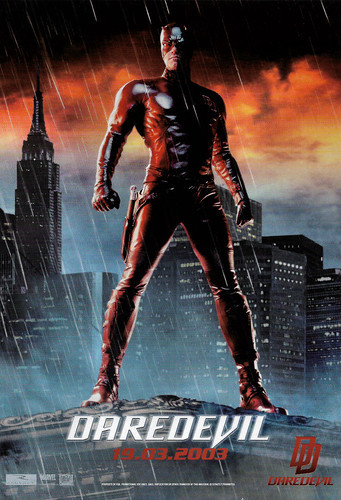
Belgian postcard by Boomerang Free Cards, no. 1/4. Image: Marvel / Regency / 20th Century Fox. Ben Affleck in Daredevil (Mark Steven Johnson, 2003).

Dutch postcard by Boomerang Freecards for H & M, no. P 20-98. Gary Oldman .

Dutch postcard by Boomerang Studycards, Amsterdam, no. P08-03, 2003. Keanu Reeves in The Matrix Reloaded (Lana Wachowski, Lilly Wachowski, 2003).
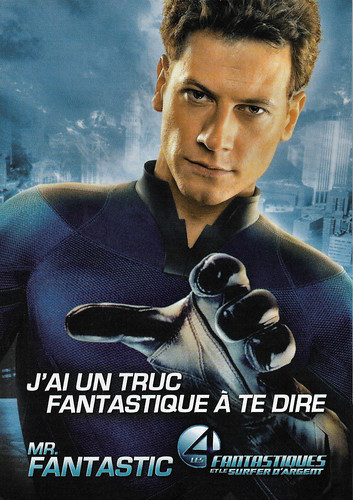
Belgian postcard by Boomerang.be. Image: Marvel / 20th Century Fox. Ioan Gruffudd as Mr. Fantastic / Reed Richards in Fantastic 4: Rise of the Silver Surfer (Tim Story, 2007). Caption: I have a fantastic thing to tell you.
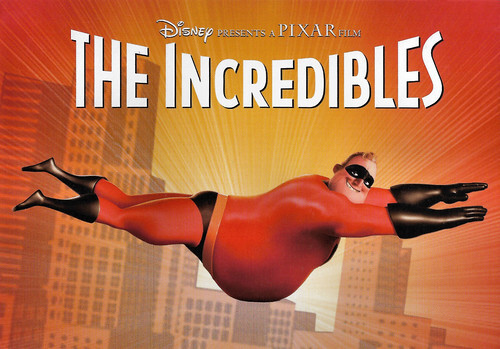
Belgian postcard by Boomerang. Image: Disney / Pixar. The Incredibles (Brad Bird, 2004). Caption: Now on DVD!
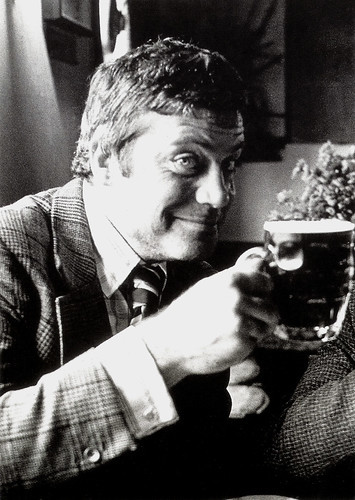
British postcard in the 'Greatest' Series - Drunks by Boomerang. Photo: John Curtis / Rex. Oliver Reed .
Sources: Boomerang.nl (Dutch) and VDP (Dutch).

Dutch postcard by Boomerang, Amsterdam. Photo: Al Pacino in Carlito's Way (Brian De Palma, 1993).

Dutch postcard by Boomerang Freecards, Amsterdam. Photo: Sharon Stone in Casino (Martin Scorsese, 1995).

Dutch postcard by Boomerang, no. P18-06. Photo: Frans Jansen / BNN. Sexy and exotic Katja Schuurman (1975) was one of the first soap stars of the Netherlands. She showed durability as a TV host and as an actress in many TV series and films.

Belgian postcard by Boomerang Free Cards. Photo: Warner Bros. Jim Carrey as Riddler in Batman Forever (Joel Schumacher, 1995).

Dutch postcard by Boomerang Freecards, Amsterdam. Nicole Kidman in The Portrait of a Lady (Jane Campion, 1996). Captions: I'm absolutely in love with you (front). After 'The Piano' the new film by Jane Campion.

British postcard by Boomerang Media. Photo: Paramount. Val Kilmer in The Saint (Philip Noyce, 1997).

British freecard by Boomerang. Winona Ryder in Girl, Interrupted (James Mangold, 1999). Captions: The crazy thing is, you're not crazy. Girl, Interrupted. Based on a true story. Opens March 24 at Cinemas across the country.
The Freecards phenomenon
Freecards are free postcards that are distributed in different ways. Some publishers distribute the cards via their own racks, which are hung up in hotels, restaurants, schools, gyms and/or on golf courses. Other publishers offer the cards through bookstores, cinemas, at events, or in (their own) shops.
The first publisher of freecards was Vanguardia in Spain in 1985. France followed in 1987, Italy in 1989, Denmark in 1990, Belgium and Sweden in 1991, Germany, Switzerland, Australia, Canada and the United Kingdom in 1992, and the Netherlands and several other countries in 1993.
In the Netherlands, the freecards were initially published by Free Card and Take Art. But Boomerang took over, quickly followed by competitor Advertising Post.
The VDP (Vereniging Documentatie Prentbriefkaarten) has been busy from the beginning with documenting the released freecards in the Netherlands. In September 1994 the very first VDP freecard catalogue was published, containing all the Boomerang and Advertising Post cards released at that time. Since then the VDP and since 2003 the Boomerang Fanclub (BFC) releases a new freecard catalogue every year.

Dutch postcard by Boomerang, Amsterdam. Photo: Ray Christian / De Krom Studio. Artwork: Michiel van Randeraat / Locust Enterainment. Cas Jansen and Chantal Janzen in Volle Maan/Full Moon Party (Johan Nijenhuis, 2002).

British postcard by Boomerang Media Cards in the Best of British Quirky Traits series, no. 6, Humour. Photo: Jon Lyons. Tommy Cooper. Collection: Carla Bosch.

Dutch postcard by Boomerang. Photo: Amblin Entertainment / Columbia Pictures. Tommy Lee Jones and Will Smith in Men in Black II (Barry Sonnenfeld, 2002). Caption: Back in black.

Belgian postcard by Boomerang Free Cards, no. 1/4. Image: Marvel / Regency / 20th Century Fox. Ben Affleck in Daredevil (Mark Steven Johnson, 2003).

Dutch postcard by Boomerang Freecards for H & M, no. P 20-98. Gary Oldman .

Dutch postcard by Boomerang Studycards, Amsterdam, no. P08-03, 2003. Keanu Reeves in The Matrix Reloaded (Lana Wachowski, Lilly Wachowski, 2003).

Belgian postcard by Boomerang.be. Image: Marvel / 20th Century Fox. Ioan Gruffudd as Mr. Fantastic / Reed Richards in Fantastic 4: Rise of the Silver Surfer (Tim Story, 2007). Caption: I have a fantastic thing to tell you.

Belgian postcard by Boomerang. Image: Disney / Pixar. The Incredibles (Brad Bird, 2004). Caption: Now on DVD!

British postcard in the 'Greatest' Series - Drunks by Boomerang. Photo: John Curtis / Rex. Oliver Reed .
Sources: Boomerang.nl (Dutch) and VDP (Dutch).
Published on April 15, 2022 22:00
April 14, 2022
Tanti auguri, Claudia!
Today is the birthday of our favourite film stars, Claudia Cardinale (1938). The combination of her beauty, dark, flashing eyes, explosive sexuality and genuine acting talent made her a global super star. We salute her today for her unforgettable roles in 8½ (Federico Fellini, 1963), Il Gattopardo/The Leopard (Luchino Visconti, 1963), Once Upon a Time in the West (Sergio Leone, 1968), and so many, many other films. Tanti auguri, Claudia!.
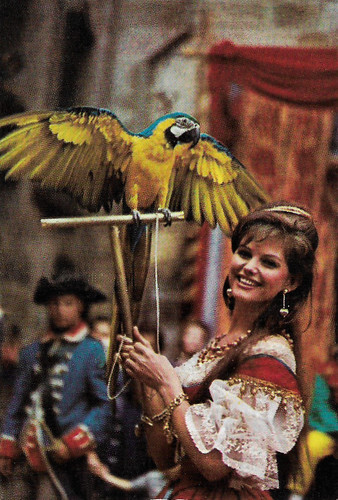
Belgian collectors card no. 25 (of 26). Claudia Cardinale in Cartouche (Philippe de Broca, 1962).
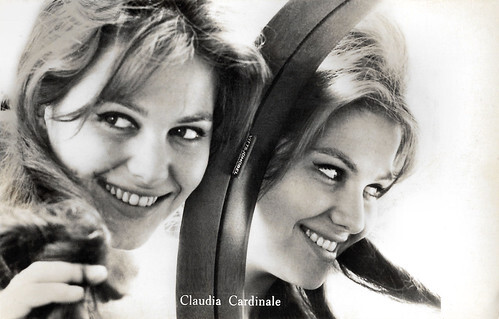
Dutch postcard by Hercules, Haarlem, no. 252.
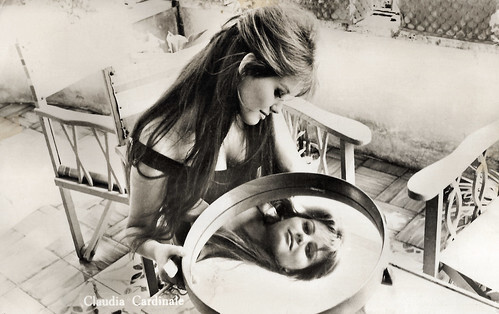
Dutch postcard by Hercules, Haarlem, no. 262.
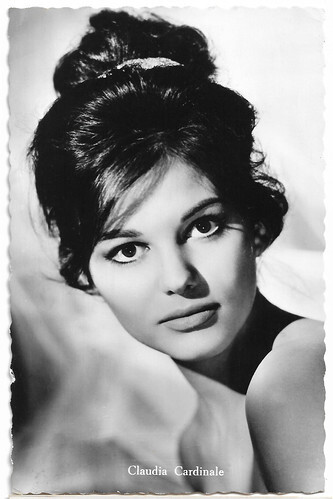
Dutch postcard.
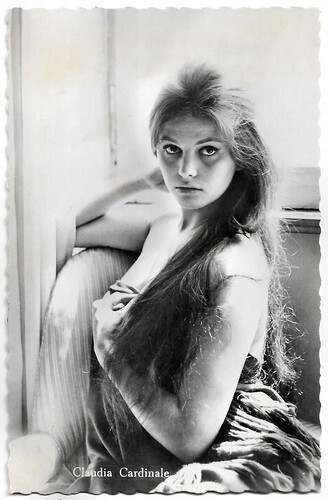
Dutch postcard. Sent by mail in 1962.
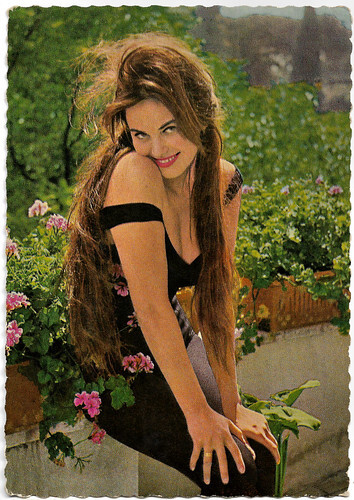
Italian postcard by Ufa (Universion Film Aktiengesellschaft), Berlin-Tempelhof, no. CK 425. Photo: Herbert Fried / Ufa.
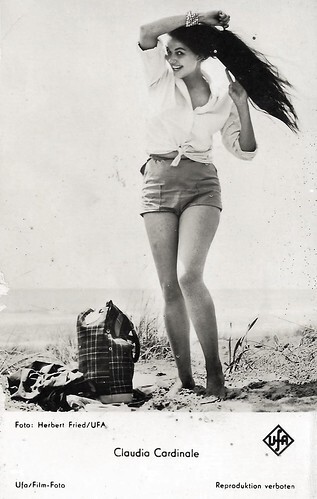
German postcard. Photo: Herbert Fried / Ufa.
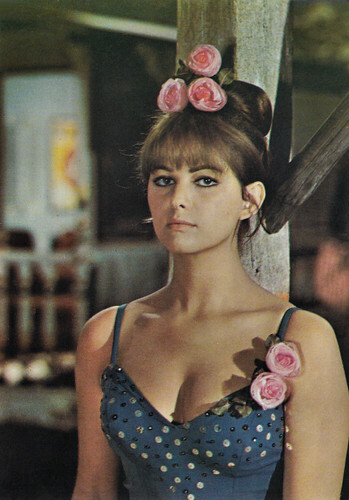
Belgian postcard by Edt. Decker, Brussels, no. A. 104.
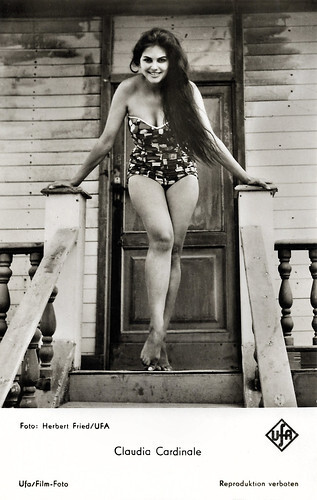
West-German postcard by Ufa/Film-Foto, Berlin-Tempelhof, no. FK 5143. Photo: Herbert Fried / Ufa.
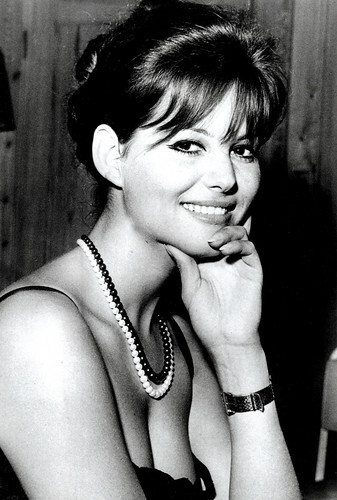
Vintage photo.
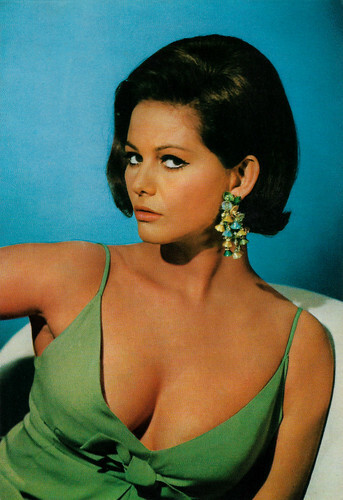
Italian postcard by Rotalfoto, Milano (Rotalcolor), no. 240.
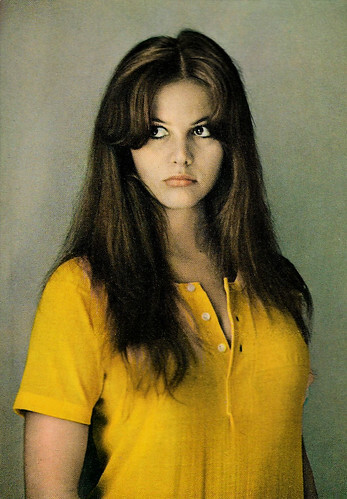
Italian postcard by Rotalfoto (Rotalcolor), Milano, no. N. 203.
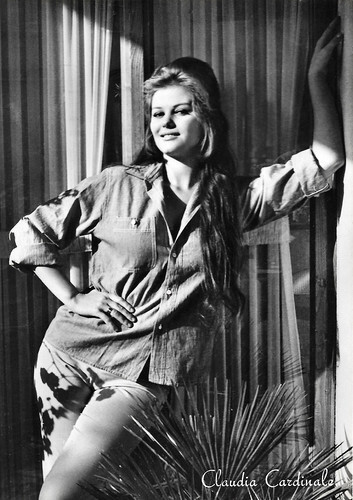
Italian postcard by Rotalfoto, Milano, no. 922.
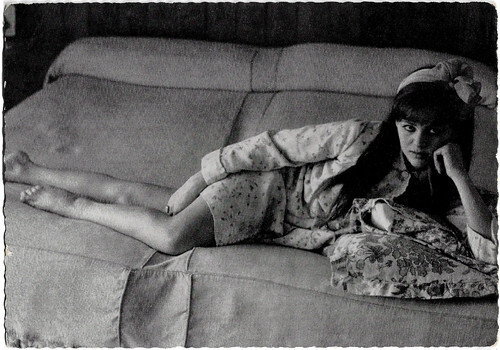
German postcard by Filmbilder-Vertrieb Ernst Freihoff, Essen, no. 893. Photo: Lothar Winkler.
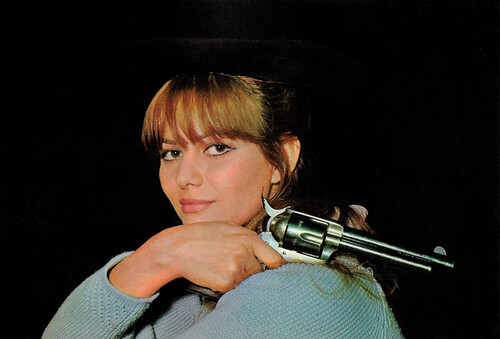
Italian postcard by SAG, Trieste, Serie, no. 10.
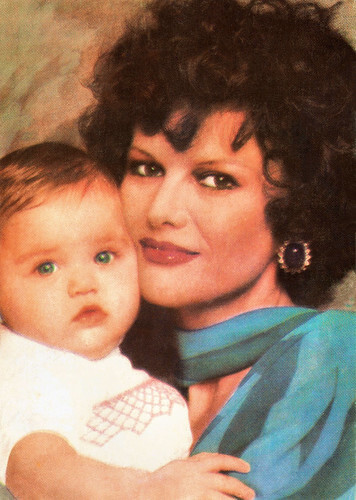
Romanian postcard by Casa Filmului Acin. Claudia Cardinale and daughter Claudia Squitieri.

Belgian collectors card no. 25 (of 26). Claudia Cardinale in Cartouche (Philippe de Broca, 1962).

Dutch postcard by Hercules, Haarlem, no. 252.

Dutch postcard by Hercules, Haarlem, no. 262.

Dutch postcard.

Dutch postcard. Sent by mail in 1962.

Italian postcard by Ufa (Universion Film Aktiengesellschaft), Berlin-Tempelhof, no. CK 425. Photo: Herbert Fried / Ufa.

German postcard. Photo: Herbert Fried / Ufa.

Belgian postcard by Edt. Decker, Brussels, no. A. 104.

West-German postcard by Ufa/Film-Foto, Berlin-Tempelhof, no. FK 5143. Photo: Herbert Fried / Ufa.

Vintage photo.

Italian postcard by Rotalfoto, Milano (Rotalcolor), no. 240.

Italian postcard by Rotalfoto (Rotalcolor), Milano, no. N. 203.

Italian postcard by Rotalfoto, Milano, no. 922.

German postcard by Filmbilder-Vertrieb Ernst Freihoff, Essen, no. 893. Photo: Lothar Winkler.

Italian postcard by SAG, Trieste, Serie, no. 10.

Romanian postcard by Casa Filmului Acin. Claudia Cardinale and daughter Claudia Squitieri.
Published on April 14, 2022 22:00
April 13, 2022
Vija Artmane
Vija Artmane (1929-2008) was a popular Latvian stage and screen actress, who had her film breakthrough with Rodnaya krov/Blood Ties (1964) and was henceforth called "Mother Latvia". She enjoyed a steady film career in the Soviet Union during the 1960s, 1970s, and 1980s.
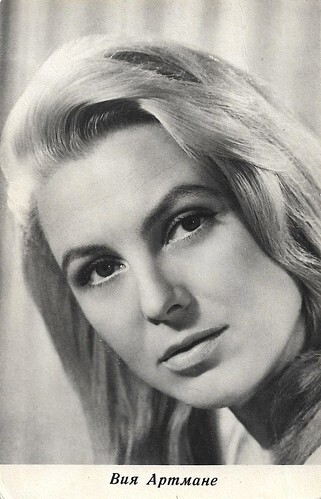
Sovietrussian postcard by Leningrad buro otd. propaganda iskusstvo, no. C. 1972-73.
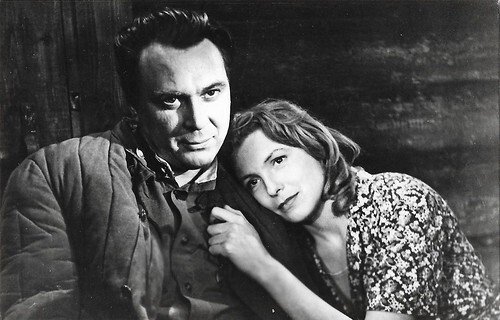
Latvian postcard by Latvian branch of the All-union bureau of cinematographic propaganda, Riga, 1982. Photo: Lenfilm. Vija Artmane and Evgeniy Matveev in Rodnaya krov/Blood Ties (Mikhail Yershov, 1964). The film deals with a soldier on leave (Matveev) who stops to help a woman (Artmane) run a ferry and bring up her three children while her husband is away at war.
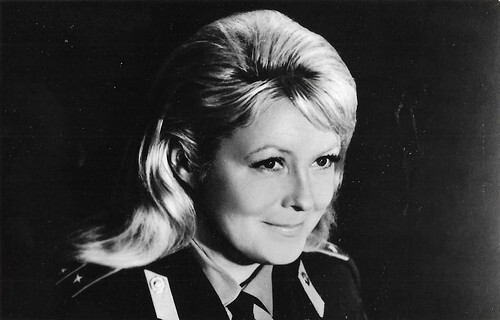
Latvian postcard by Latvian branch of the All-union bureau of cinematographic propaganda, Riga, 1982. Vija Artmane in Davana vientulai sievietei/Gift for the Single Woman (Eriks Lacis 1973).
Juliet of Romeo
Alida Fritsevna Artmane was born in 1929 in the Latvian village of Kaivė near Tukums, at the time when Latvia was a sovereign nation. Her parents, Fritsis Artmane and Anna Zaborska, owned a farm there. Her father died in an accident aged 19, four months before she was born and her Polish mother survived as a single mother by doing seasonal agricultural jobs.
Artmane grew up playing in the fields. While her mother worked for a landlord, her master sent young Artmane to study music and dance at a ballet class for a couple of years. At the age of 10, young Artmane became a shepherd girl. She worked with a herd of cows for five years and survived until the end of the Second World War.
In 1946 she graduated from secondary school and had a dream of becoming a lawyer in order to make the world a better place. At the same time, she was involved in amateur acting at her school and became interested in film and theatre, and eventually, her passion for acting prevailed. She changed her first name to Vija. From 1946 to 1949, she studied at the Second Studio of the Dailes Theatre and became an actress at the Dailes Theatre in 1949. She would be a member of the troupe for the next 50 years. In 1950 she became a member of the Latvian Theatre Union.
When she started to work at the theatre, she quickly attracted the attention of the legendary Latvian theatre director Eduards Smiļģis, founder and main director of the Daile Theater. From 1949 to 1998 Artmane was the leading star of the troupe at the Daile Theatre in Riga. Her first big success came with the role of Juliet in Shakespeare's 'Romeo and Juliet' (1953), where her partner was Eduards Pāvuls. Another success was her role as Eliza Doolittle in George Bernard Shaw's 'Pygmalion'.
Artmane also created important roles in Latvian plays such as 'Indulis and Ārija' and 'Fire and Night' under the direction of the National Actor of Latvia, Rainis. She was critically acclaimed for her stage works in Russian plays, such as her passionate performance as Tolstoy's heroine 'Anna Karenina'; she also played in Tolstoy's 'War and Peace', in Gogol's 'Dead Souls', and other classic Russian plays.
In 1953, Artmane married the Dailes Theatre actor Artūrs Dimiters (1915-1986). They had two children - musician Kaspars Dimiters (1957) and artist Kristiāna Dimitere (1965).
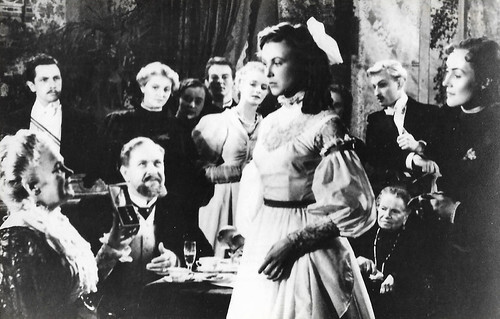
Latvian postcard by Latvian branch of the All-union bureau of cinematographic propaganda, Riga, 1982. Vija Artmane in Za lebedinov staey oblakov/Following the Swan Flock of Clouds (Pavel Armand, 1957).
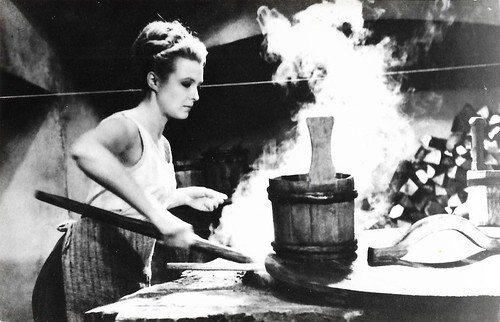
Latvian (former Sovietunion) postcard by Latvian branch of the All-union bureau of cinematographic propaganda, Riga, 1982. Photo: Rigas Kinostudija. Vija Artmane in Purva bridejs/Edgar and Kristina (Leonids Leimanis, 1966). NB the card dates the film as of 1967, IMDb as of 1966. The plot, set in late 19th century Latvia, deals with the coachman Edgar (Uldis Pucitis) who is in love with the maid Kristina (Artmane), though he is unable to overcome her mother's resistance. A charming, wealthy suitor arrives with a proposal but Kristina just can't forget Edgar.
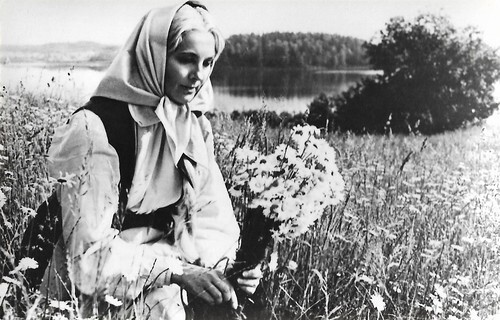
Latvian postcard by Latvian branch of the All-union bureau of cinematographic propaganda, Riga, 1982. Vija Artmane in the Latvian/Russian film Mernieku laiki/The Times of the Surveyors (Voldemars Puce, 1970).
A beautiful and loving mother
Vija Artmane's first screen role came in 1956 in Rolands Kalniņš's film Posle shtorma/After the Storm (1957).
She really came to prominence with the role of Dace in Pāvels Armand's film Kā gulbji balti padebeši iet/Following the Swan Flock of Clouds (1956). It was the real beginning of her film career. In 1958, she became a member of the Union of Latvian Filmmakers.
In 1964 she shot to fame in the Soviet Union with her leading role as Sonya, a beautiful and loving mother, opposite Evgeni Matveev in the popular film Rodnaya krov/Blood Ties. After that film, Artmane was nicknamed "Mother-Latvia" in her homeland.
She enjoyed a steady film career in the Soviet Union during the 1960s, 1970s, and 1980s. Her film career was highlighted with such roles as Veda Kong in the popular Science Fiction film Tumannost' Andromedy/Andromeda Nebula (Evgeniy Sherstobitov, 1967), as Empress Catherine the Great in the historical drama Emelyan Pugachev/Pugachev (Aleksei Saltykov, 1978), and as Julia Lambert in the film Teātris/Theatre (Janis Streics, 1978).
Vija Artmane appeared as herself in a documentary on her life entitled Saruna ar karalieni/Conversation with the Queen (Rolands Kalnins, 1980) which was produced at the Riga Film Studio. From 1998 to 2000 she worked with the New Riga Theatre. There she appeared in the title role in a stage production of 'Queen of Spades' based on the eponymous drama by Alexander Pushkin. Her most recent film is Zolotoy vek/The Golden Age (Ilya Khotinenko, 2003).
All in all, Vija Artmane was one of the most outstanding Latvian theater and film actresses of the 20th century. In total, she played at least 85 roles on stage and 50 on-screen. In 1986, after the death of her husband, she suffered from an emotional breakdown and later had a stroke. In the 1990s, Artmane moved out of the city of Riga and settled in the countryside. In the early 2000s, she converted to Eastern Orthodoxy. In 2004 she published 'Ziemcieši. Mirkļi no manas dzīves', a book of memoirs covering her acting career as well as her personal life. She died in 2008 and is buried in the Pokrov Cemetery in Riga.
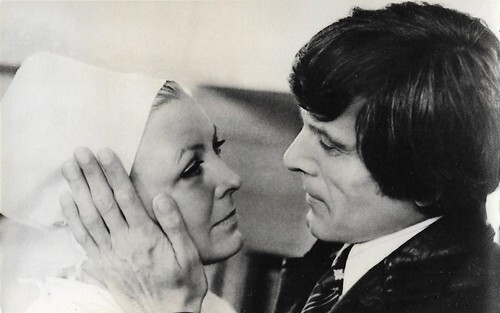
Latvian postcard by Latvian branch of the All-union bureau of cinematographic propaganda, Riga, 1982. Vija Artmane and Igor Ledogorov in Tavs dels/Your Son (Gunars Piesis, 1978). Plot: The mother (Artmane) of an adult son falls in love and now she has to decide whether to arrange her fate or to obey the egoism of her child, who does not want to "share" her mother with anyone.
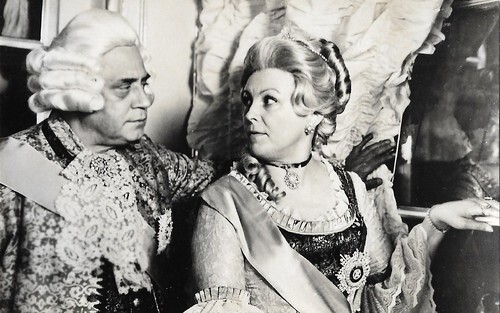
Latvian postcard by Latvian branch of the All-union bureau of cinematographic propaganda, Riga, 1982. Photo: Mosfilm. Vija Artmane as Catherine the Great and Igor Gorbachyov as Nikita Panin, Catherine's mentor, in Emelyan Pugachev/Pugachev (Aleksei Saltykov, 1978-79). Plot: Don Cossack Yemelyan/ Emelyan Pugachev (Evgeniy Matveev) says goodbye to his wife and children and intends to leave, but the elder Filaret begs him to stay and lead a rebellion under the insignia of Peter III of Russia. The rebels led by Pugachev then attack the landowners. Tsarina Catherine II, however, sends troops against the rebels to repress them. Due to a betrayal Pugachev is captured, and later transported across Russia locked in an iron cage.
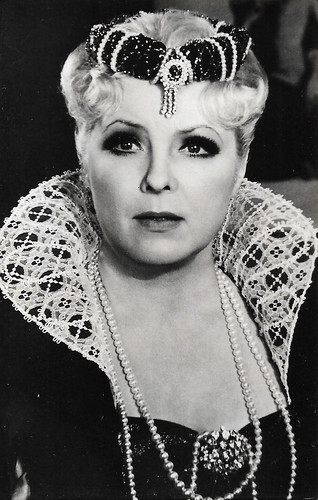
Latvian postcard by Latvian branch of the All-union bureau of cinematographic propaganda, Riga, 1982. Photo: Rigas Kinostudija. Vija Artmane as Julia Lambert in the Somerset Maugham adaptation of 'Theatre': Teatris (Janis Streics, 1978). The plot deals with a popular, slightly elder stage actress, Julia Lambert, whose husband Michel is understanding but also a bit dull. Julia is vain and self-centered, but then she falls in love with Paul, a younger man, who is rather a career hunter and loves an ambitious upcoming actress. The plot, set to play by Guy Bolton, was later filmed and televised several times, with e.g. Danielle Darrieux and Annette Benning as Julia.
Sources: (IMDb), Wikipedia (English and German), and

Sovietrussian postcard by Leningrad buro otd. propaganda iskusstvo, no. C. 1972-73.

Latvian postcard by Latvian branch of the All-union bureau of cinematographic propaganda, Riga, 1982. Photo: Lenfilm. Vija Artmane and Evgeniy Matveev in Rodnaya krov/Blood Ties (Mikhail Yershov, 1964). The film deals with a soldier on leave (Matveev) who stops to help a woman (Artmane) run a ferry and bring up her three children while her husband is away at war.

Latvian postcard by Latvian branch of the All-union bureau of cinematographic propaganda, Riga, 1982. Vija Artmane in Davana vientulai sievietei/Gift for the Single Woman (Eriks Lacis 1973).
Juliet of Romeo
Alida Fritsevna Artmane was born in 1929 in the Latvian village of Kaivė near Tukums, at the time when Latvia was a sovereign nation. Her parents, Fritsis Artmane and Anna Zaborska, owned a farm there. Her father died in an accident aged 19, four months before she was born and her Polish mother survived as a single mother by doing seasonal agricultural jobs.
Artmane grew up playing in the fields. While her mother worked for a landlord, her master sent young Artmane to study music and dance at a ballet class for a couple of years. At the age of 10, young Artmane became a shepherd girl. She worked with a herd of cows for five years and survived until the end of the Second World War.
In 1946 she graduated from secondary school and had a dream of becoming a lawyer in order to make the world a better place. At the same time, she was involved in amateur acting at her school and became interested in film and theatre, and eventually, her passion for acting prevailed. She changed her first name to Vija. From 1946 to 1949, she studied at the Second Studio of the Dailes Theatre and became an actress at the Dailes Theatre in 1949. She would be a member of the troupe for the next 50 years. In 1950 she became a member of the Latvian Theatre Union.
When she started to work at the theatre, she quickly attracted the attention of the legendary Latvian theatre director Eduards Smiļģis, founder and main director of the Daile Theater. From 1949 to 1998 Artmane was the leading star of the troupe at the Daile Theatre in Riga. Her first big success came with the role of Juliet in Shakespeare's 'Romeo and Juliet' (1953), where her partner was Eduards Pāvuls. Another success was her role as Eliza Doolittle in George Bernard Shaw's 'Pygmalion'.
Artmane also created important roles in Latvian plays such as 'Indulis and Ārija' and 'Fire and Night' under the direction of the National Actor of Latvia, Rainis. She was critically acclaimed for her stage works in Russian plays, such as her passionate performance as Tolstoy's heroine 'Anna Karenina'; she also played in Tolstoy's 'War and Peace', in Gogol's 'Dead Souls', and other classic Russian plays.
In 1953, Artmane married the Dailes Theatre actor Artūrs Dimiters (1915-1986). They had two children - musician Kaspars Dimiters (1957) and artist Kristiāna Dimitere (1965).

Latvian postcard by Latvian branch of the All-union bureau of cinematographic propaganda, Riga, 1982. Vija Artmane in Za lebedinov staey oblakov/Following the Swan Flock of Clouds (Pavel Armand, 1957).

Latvian (former Sovietunion) postcard by Latvian branch of the All-union bureau of cinematographic propaganda, Riga, 1982. Photo: Rigas Kinostudija. Vija Artmane in Purva bridejs/Edgar and Kristina (Leonids Leimanis, 1966). NB the card dates the film as of 1967, IMDb as of 1966. The plot, set in late 19th century Latvia, deals with the coachman Edgar (Uldis Pucitis) who is in love with the maid Kristina (Artmane), though he is unable to overcome her mother's resistance. A charming, wealthy suitor arrives with a proposal but Kristina just can't forget Edgar.

Latvian postcard by Latvian branch of the All-union bureau of cinematographic propaganda, Riga, 1982. Vija Artmane in the Latvian/Russian film Mernieku laiki/The Times of the Surveyors (Voldemars Puce, 1970).
A beautiful and loving mother
Vija Artmane's first screen role came in 1956 in Rolands Kalniņš's film Posle shtorma/After the Storm (1957).
She really came to prominence with the role of Dace in Pāvels Armand's film Kā gulbji balti padebeši iet/Following the Swan Flock of Clouds (1956). It was the real beginning of her film career. In 1958, she became a member of the Union of Latvian Filmmakers.
In 1964 she shot to fame in the Soviet Union with her leading role as Sonya, a beautiful and loving mother, opposite Evgeni Matveev in the popular film Rodnaya krov/Blood Ties. After that film, Artmane was nicknamed "Mother-Latvia" in her homeland.
She enjoyed a steady film career in the Soviet Union during the 1960s, 1970s, and 1980s. Her film career was highlighted with such roles as Veda Kong in the popular Science Fiction film Tumannost' Andromedy/Andromeda Nebula (Evgeniy Sherstobitov, 1967), as Empress Catherine the Great in the historical drama Emelyan Pugachev/Pugachev (Aleksei Saltykov, 1978), and as Julia Lambert in the film Teātris/Theatre (Janis Streics, 1978).
Vija Artmane appeared as herself in a documentary on her life entitled Saruna ar karalieni/Conversation with the Queen (Rolands Kalnins, 1980) which was produced at the Riga Film Studio. From 1998 to 2000 she worked with the New Riga Theatre. There she appeared in the title role in a stage production of 'Queen of Spades' based on the eponymous drama by Alexander Pushkin. Her most recent film is Zolotoy vek/The Golden Age (Ilya Khotinenko, 2003).
All in all, Vija Artmane was one of the most outstanding Latvian theater and film actresses of the 20th century. In total, she played at least 85 roles on stage and 50 on-screen. In 1986, after the death of her husband, she suffered from an emotional breakdown and later had a stroke. In the 1990s, Artmane moved out of the city of Riga and settled in the countryside. In the early 2000s, she converted to Eastern Orthodoxy. In 2004 she published 'Ziemcieši. Mirkļi no manas dzīves', a book of memoirs covering her acting career as well as her personal life. She died in 2008 and is buried in the Pokrov Cemetery in Riga.

Latvian postcard by Latvian branch of the All-union bureau of cinematographic propaganda, Riga, 1982. Vija Artmane and Igor Ledogorov in Tavs dels/Your Son (Gunars Piesis, 1978). Plot: The mother (Artmane) of an adult son falls in love and now she has to decide whether to arrange her fate or to obey the egoism of her child, who does not want to "share" her mother with anyone.

Latvian postcard by Latvian branch of the All-union bureau of cinematographic propaganda, Riga, 1982. Photo: Mosfilm. Vija Artmane as Catherine the Great and Igor Gorbachyov as Nikita Panin, Catherine's mentor, in Emelyan Pugachev/Pugachev (Aleksei Saltykov, 1978-79). Plot: Don Cossack Yemelyan/ Emelyan Pugachev (Evgeniy Matveev) says goodbye to his wife and children and intends to leave, but the elder Filaret begs him to stay and lead a rebellion under the insignia of Peter III of Russia. The rebels led by Pugachev then attack the landowners. Tsarina Catherine II, however, sends troops against the rebels to repress them. Due to a betrayal Pugachev is captured, and later transported across Russia locked in an iron cage.

Latvian postcard by Latvian branch of the All-union bureau of cinematographic propaganda, Riga, 1982. Photo: Rigas Kinostudija. Vija Artmane as Julia Lambert in the Somerset Maugham adaptation of 'Theatre': Teatris (Janis Streics, 1978). The plot deals with a popular, slightly elder stage actress, Julia Lambert, whose husband Michel is understanding but also a bit dull. Julia is vain and self-centered, but then she falls in love with Paul, a younger man, who is rather a career hunter and loves an ambitious upcoming actress. The plot, set to play by Guy Bolton, was later filmed and televised several times, with e.g. Danielle Darrieux and Annette Benning as Julia.
Sources: (IMDb), Wikipedia (English and German), and
Published on April 13, 2022 22:00
April 12, 2022
Osceola (1971)
Osceola (1971) is a DEFA Ostern by director Konrad Petzold and the Red Circle group from 1971. The 'Red Western', made in cooperation with Kino-Zentrum Sofia (Bulgaria) and ICAIC Havana (Cuba), is about the struggle of the Indian chief Osceola (Gojko Mitic, of course) and his tribe for their land in southern North America, which they have to defend against rich white Americans. On the other hand, the film also deals with the role of the black population in this conflict.
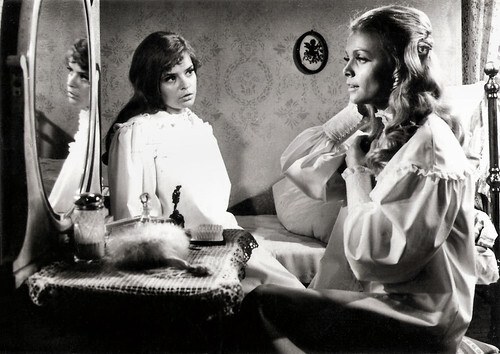
East-German postcard by VEB Progress Film-Vertrieb, Berlin, no. 5/71 D a. Photo: DEFA. Kati Bus and Karin Ugowski in Osceola (Konrad Petzold, 1971).
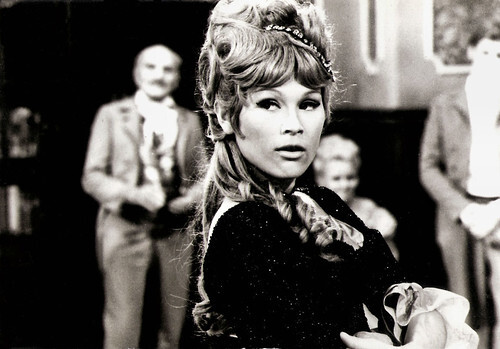
East-German postcard by VEB Progress Film-Vertrieb, Berlin, no. 5/71 D h. Photo: DEFA. Karin Ugowski in Osceola (Konrad Petzold, 1971).
The beginning of a seven-year war
Osceola (Konrad Petzold, 1971) is situated in Florida, 1830. Of all eastern Native American tribes, only the Seminoles have resisted being moved to reservations.
Having retreated to Florida, they live a simple horticultural life. But white plantation owners, angry at the increasing numbers of black slaves fleeing to Seminole protection, want to take their land.
Plantation owner Raynes (Horst Schulze), in particular, has convinced the military to wipe out the Seminoles. His rival Moore ( Iurie Darie ), a sawmill owner from the North who has a Seminole wife, is against slavery and considers it unprofitable.
Chief Osceola ( Gojko Mitic ) sees the coming danger. When a gunboat takes a large number of escaped slaves under fire, Osceola realises that he can no longer prevent the war and intervenes.
First, he frees his wife from the hands of Raynes, killing Hammer and setting fire to the mansion, then he uses a ruse to blow up the gunboat. In the end, the escaped slaves are able to flee on boats along with the Indians.
Moore, whose sawmill was destroyed by the gunboat, flees north as he no longer has a livelihood in Florida. For the Seminoles, this is the beginning of a seven-year war that will claim many more victims on both sides.
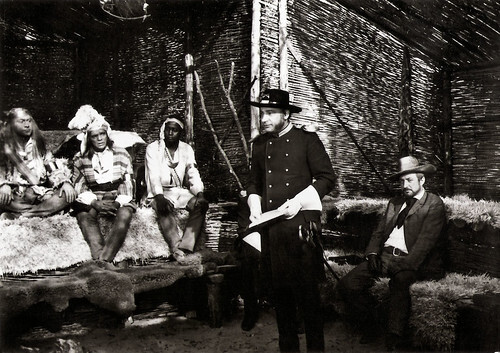
East-German postcard by VEB Progress Film-Vertrieb, Berlin. Photo: DEFA. Scene from Osceola (Konrad Petzold, 1971).
Interesting for its historical background
Osceola (1971), produced by the East German film studio DEFA, was primarily filmed in Cuba and Bulgaria by an East-German crew. The film script was written by Gunter Karl and Walter Puschel.
It was a screen adaptation of the novel 'Osceola: Leader of the Seminoles' by the English writer Thomas Mein Reed. However, the only overlapping elements bertween novel and film are a scene of negotiations between whites and Indians about relocation, during which Oceola plunges a knife into the treaty, and a fight between Indians, led by Oceola who did not agree to relocation, and Indians who did agree to relocation.
The film shows only a short period before the Second Seminole War begins, while the novel shows the fighting and a few years before the war (the story of Oceola destroying a US army ship is not in the novel). In the beginning of the novel, Oceola is a small-time planter with mixed white and Indian blood in his veins, he does not become a chief until the middle of the novel (in the movie he is only a chief).
Director Konrad Petzold had also directed the famous Yugoslav actor and "Honored Indian of the Soviet Union", Gojko Mitic ' two previous 'Osterns' (communist Westerns), Weisse Wölfe/White Wolves (1969) and Tödlicher Irrtum/Fatal Error (1970). In 1973 the film was released in the USSR and was seen by 35.3 million people.
"A straightforwardly told Indian film" was the verdict of the Encyclopaedia of International Film .
At IMDb , somebody under the name of Unbroken Metal reviews: "Osceola is a bit slow sometimes, too much singing and talking in between the action sequences, but it is interesting for its historical background, rather different from the usual Prairie Indians. Somebody gets a credit for "scientific advice" in the titles to point out it was well researched..."

East-German postcard by VEB Progress Film-Vertrieb, Berlin, no. 79/71, 1971. Photo: Schwarz / DEFA. Horst Schulze in Osceola (Konrad Petzold, 1971).
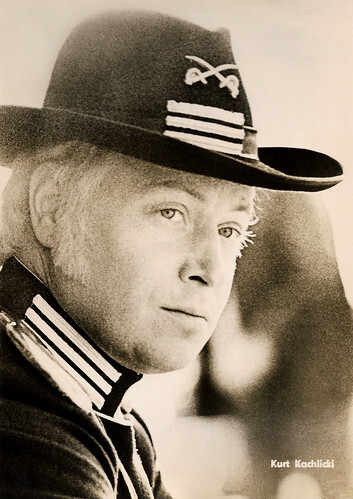
East-German postcard by VEB Progress Film-Vertrieb, Berlin, no. 101/71, 1971. Photo: Schwarz / DEFA. Kurt Kachlicki in Osceola (Konrad Petzold, 1971).
Sources: DEFA-Stiftung (German), Wikipedia (German and Russian), and IMDb.

East-German postcard by VEB Progress Film-Vertrieb, Berlin, no. 5/71 D a. Photo: DEFA. Kati Bus and Karin Ugowski in Osceola (Konrad Petzold, 1971).

East-German postcard by VEB Progress Film-Vertrieb, Berlin, no. 5/71 D h. Photo: DEFA. Karin Ugowski in Osceola (Konrad Petzold, 1971).
The beginning of a seven-year war
Osceola (Konrad Petzold, 1971) is situated in Florida, 1830. Of all eastern Native American tribes, only the Seminoles have resisted being moved to reservations.
Having retreated to Florida, they live a simple horticultural life. But white plantation owners, angry at the increasing numbers of black slaves fleeing to Seminole protection, want to take their land.
Plantation owner Raynes (Horst Schulze), in particular, has convinced the military to wipe out the Seminoles. His rival Moore ( Iurie Darie ), a sawmill owner from the North who has a Seminole wife, is against slavery and considers it unprofitable.
Chief Osceola ( Gojko Mitic ) sees the coming danger. When a gunboat takes a large number of escaped slaves under fire, Osceola realises that he can no longer prevent the war and intervenes.
First, he frees his wife from the hands of Raynes, killing Hammer and setting fire to the mansion, then he uses a ruse to blow up the gunboat. In the end, the escaped slaves are able to flee on boats along with the Indians.
Moore, whose sawmill was destroyed by the gunboat, flees north as he no longer has a livelihood in Florida. For the Seminoles, this is the beginning of a seven-year war that will claim many more victims on both sides.

East-German postcard by VEB Progress Film-Vertrieb, Berlin. Photo: DEFA. Scene from Osceola (Konrad Petzold, 1971).
Interesting for its historical background
Osceola (1971), produced by the East German film studio DEFA, was primarily filmed in Cuba and Bulgaria by an East-German crew. The film script was written by Gunter Karl and Walter Puschel.
It was a screen adaptation of the novel 'Osceola: Leader of the Seminoles' by the English writer Thomas Mein Reed. However, the only overlapping elements bertween novel and film are a scene of negotiations between whites and Indians about relocation, during which Oceola plunges a knife into the treaty, and a fight between Indians, led by Oceola who did not agree to relocation, and Indians who did agree to relocation.
The film shows only a short period before the Second Seminole War begins, while the novel shows the fighting and a few years before the war (the story of Oceola destroying a US army ship is not in the novel). In the beginning of the novel, Oceola is a small-time planter with mixed white and Indian blood in his veins, he does not become a chief until the middle of the novel (in the movie he is only a chief).
Director Konrad Petzold had also directed the famous Yugoslav actor and "Honored Indian of the Soviet Union", Gojko Mitic ' two previous 'Osterns' (communist Westerns), Weisse Wölfe/White Wolves (1969) and Tödlicher Irrtum/Fatal Error (1970). In 1973 the film was released in the USSR and was seen by 35.3 million people.
"A straightforwardly told Indian film" was the verdict of the Encyclopaedia of International Film .
At IMDb , somebody under the name of Unbroken Metal reviews: "Osceola is a bit slow sometimes, too much singing and talking in between the action sequences, but it is interesting for its historical background, rather different from the usual Prairie Indians. Somebody gets a credit for "scientific advice" in the titles to point out it was well researched..."

East-German postcard by VEB Progress Film-Vertrieb, Berlin, no. 79/71, 1971. Photo: Schwarz / DEFA. Horst Schulze in Osceola (Konrad Petzold, 1971).

East-German postcard by VEB Progress Film-Vertrieb, Berlin, no. 101/71, 1971. Photo: Schwarz / DEFA. Kurt Kachlicki in Osceola (Konrad Petzold, 1971).
Sources: DEFA-Stiftung (German), Wikipedia (German and Russian), and IMDb.
Published on April 12, 2022 22:00
Paul van Yperen's Blog
- Paul van Yperen's profile
- 13 followers
Paul van Yperen isn't a Goodreads Author
(yet),
but they
do have a blog,
so here are some recent posts imported from
their feed.



